We Have Found a Few Great Camp Cooking Knives that have their Place at the Campfire
Good food needs good tools, even if it isn’t in the kitchen. The older we get the more we find we need good food on our camping trips, so we put together this list of our favorite outdoor-friendly knives to cook with.
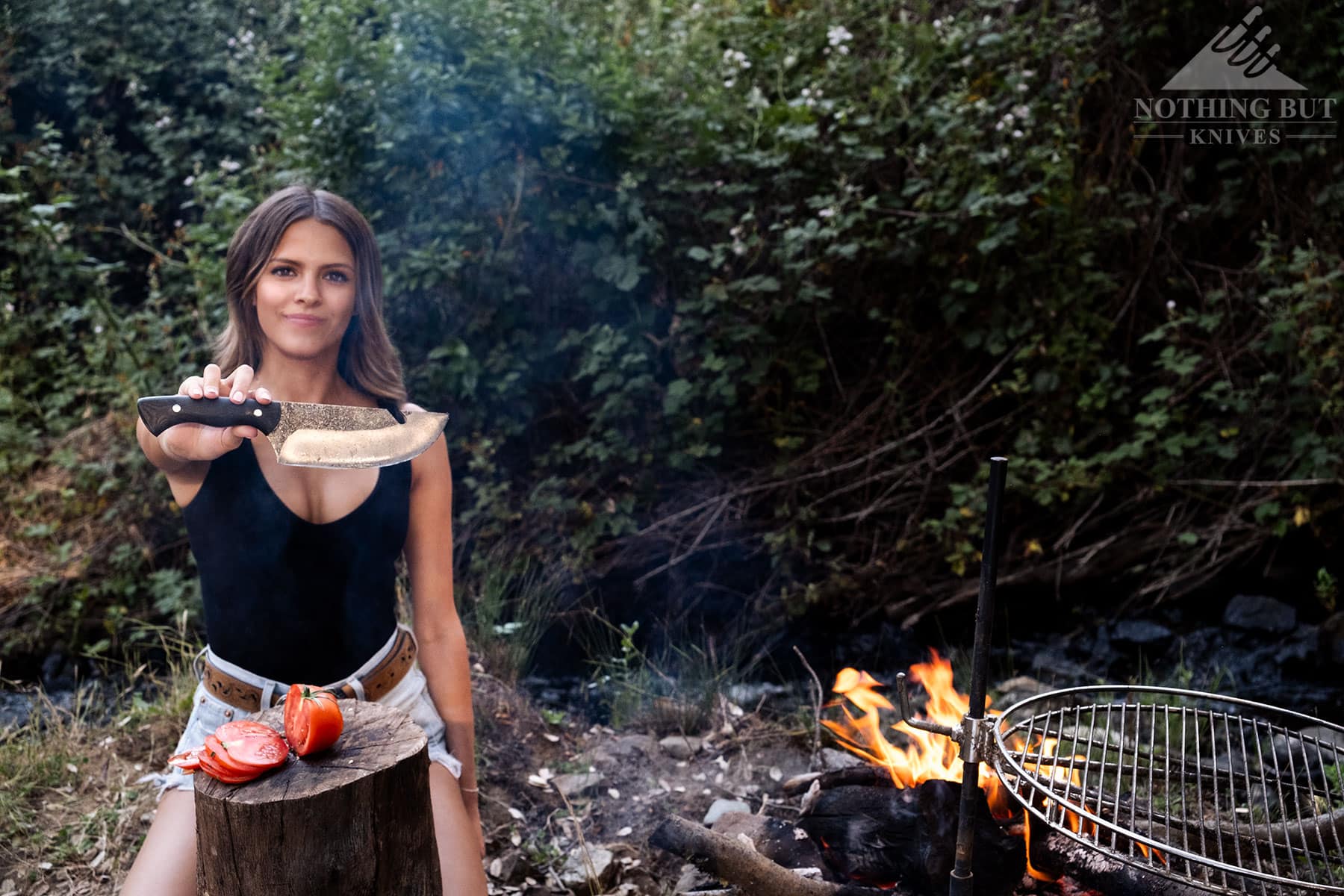
Most of these knives we used with a single cast iron pan, grill, and a stump. Sometimes there was a cutting board when we had room to pack it along, but we also went out for some side-by-side testing for the initial round of picks, and that involved a picnic table by necessity.
That means that each of the knives on here have been used beyond the bounds of what a regular kitchen knife is used for, which brings us to the crux of the matter:
Table of Contents
Off Grid Grizzly V2
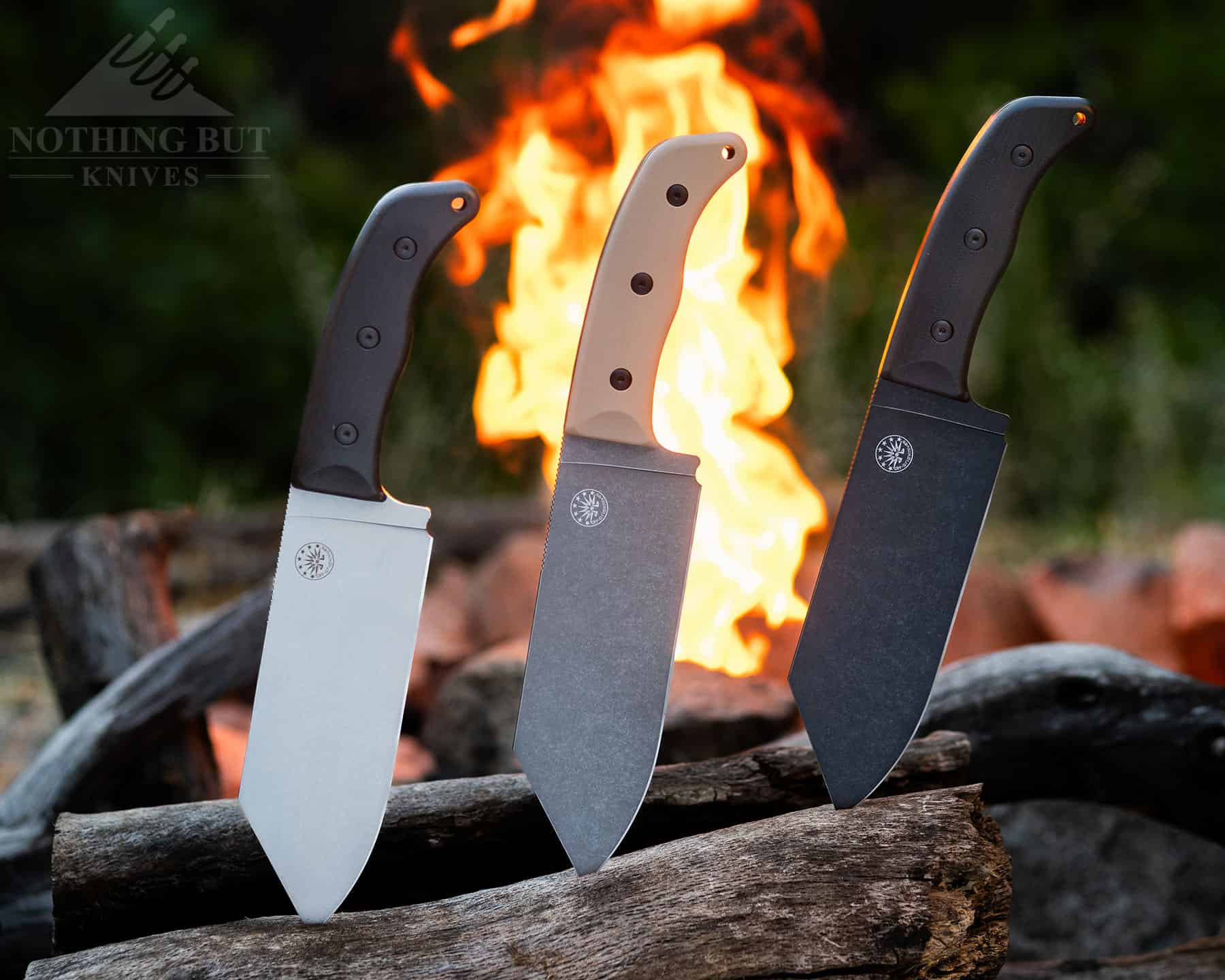
| Overall Length: | 12.75” |
| Blade Length: | 6.125” |
| Blade Steel: | 14C28N |
| Blade Shape: | Reverse tanto |
| Blade Grind: | Flat |
| Handle Length: | 4.75” |
| Handle Material: | G-10 |
| Weight: | 11.1 oz (12.9 w/ sheath) |
| Sheath: | Kydex |
| Made in: | Taiwan |
| Designer: | Cary Orefice |
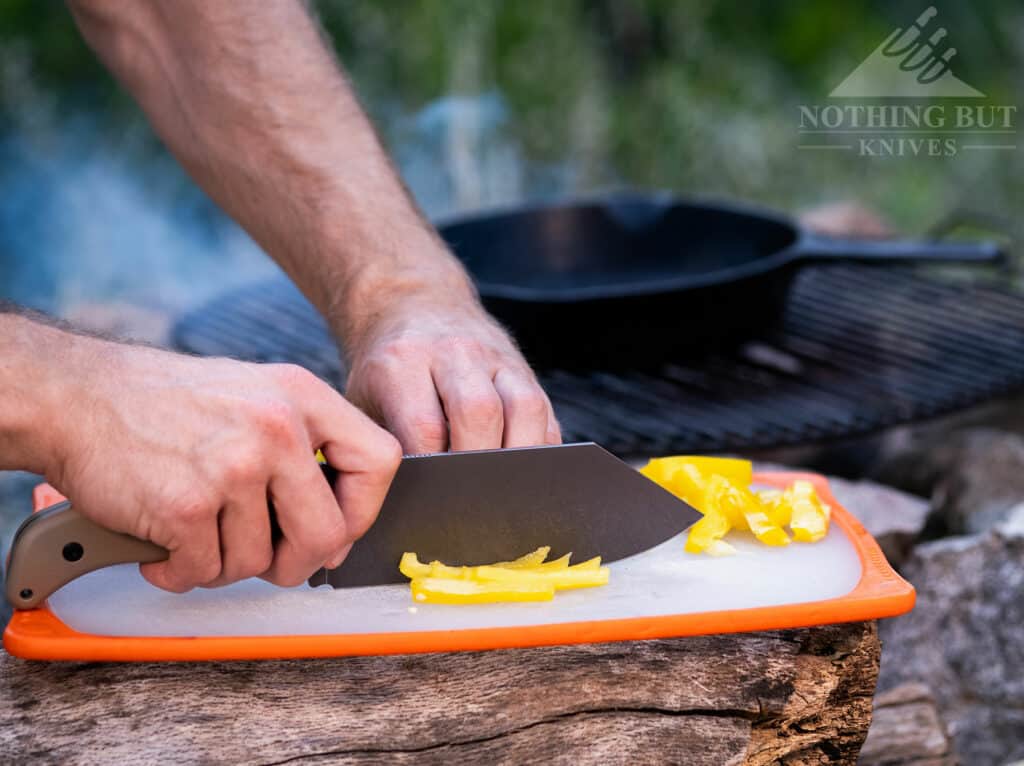
The Grizzly V2 cuts so much smoother than it looks like it should, but that’s par for the course with Off-Grid Knives. Those people know blade geometry. So when I say that they made the Grizzly V2 with food prep in mind, it shouldn’t be surprising that it cuts as well as any high end santoku I’ve ever used.
The edge cuts so well because it’s very thin, so bear in mind that the edge should stay within the range of food preparation.
Top that off with the meaty handle with a bit of tapering at the top, and you have something that genuinely feels like a respectable kitchen knife.
Off-Grid chose to go with Sandvik 14C28N steel in the upgraded version of the Grizzly which has better edge retention than the AUS8 steel used in the original version without sacrificing corrosion resistance.
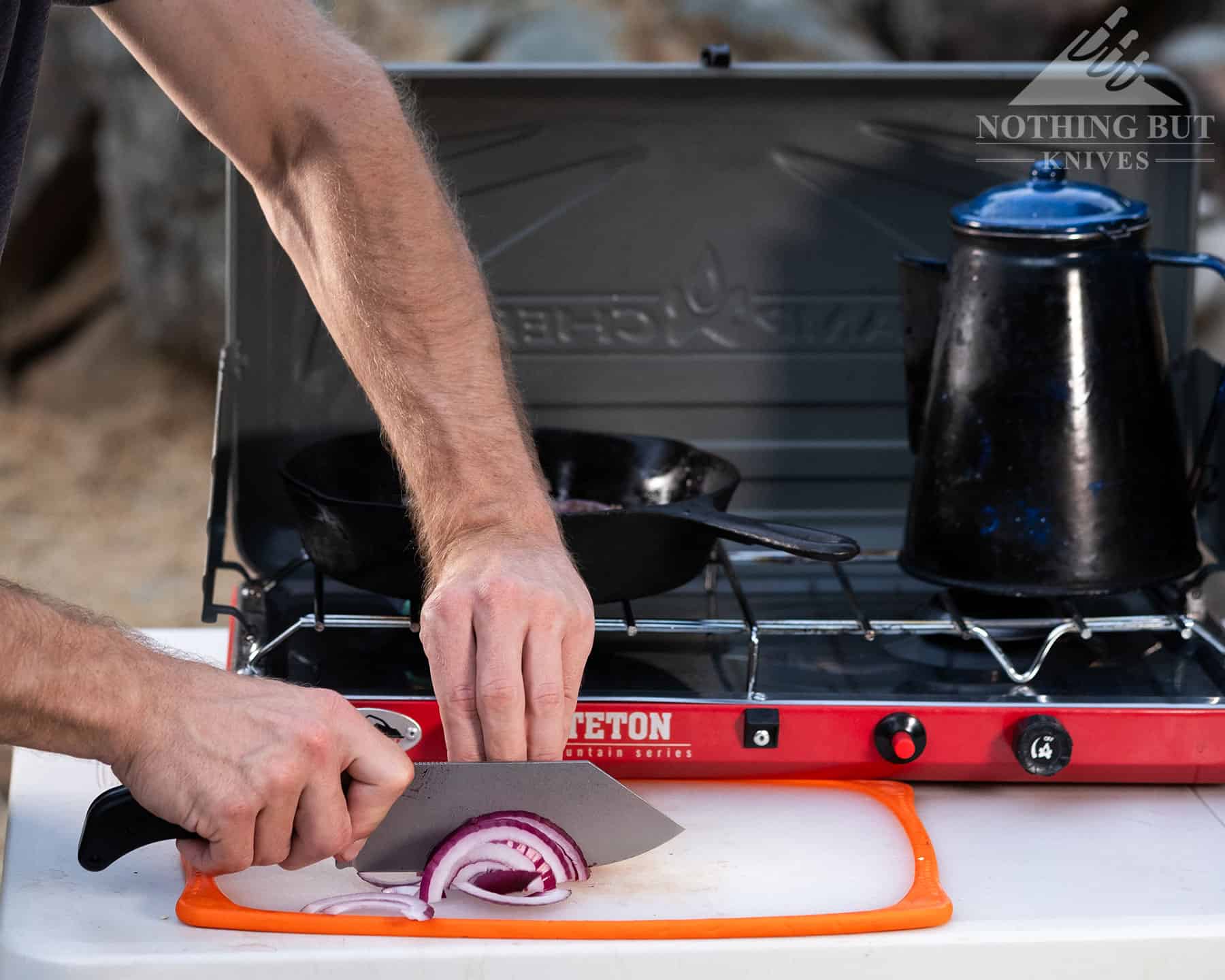
Sandvik 14C28N steel is one of our favorite steels for outdoor or indoor knives, because it is easy to sharpen, it takes a great edge, and it has good corrosion resistance. It may seem a little outdated compared to some of the modern super steels that have recently been released. But of everything we tested for this article, the Grizzly consistently stood out as one of the best in terms of comfort and cutting ability.
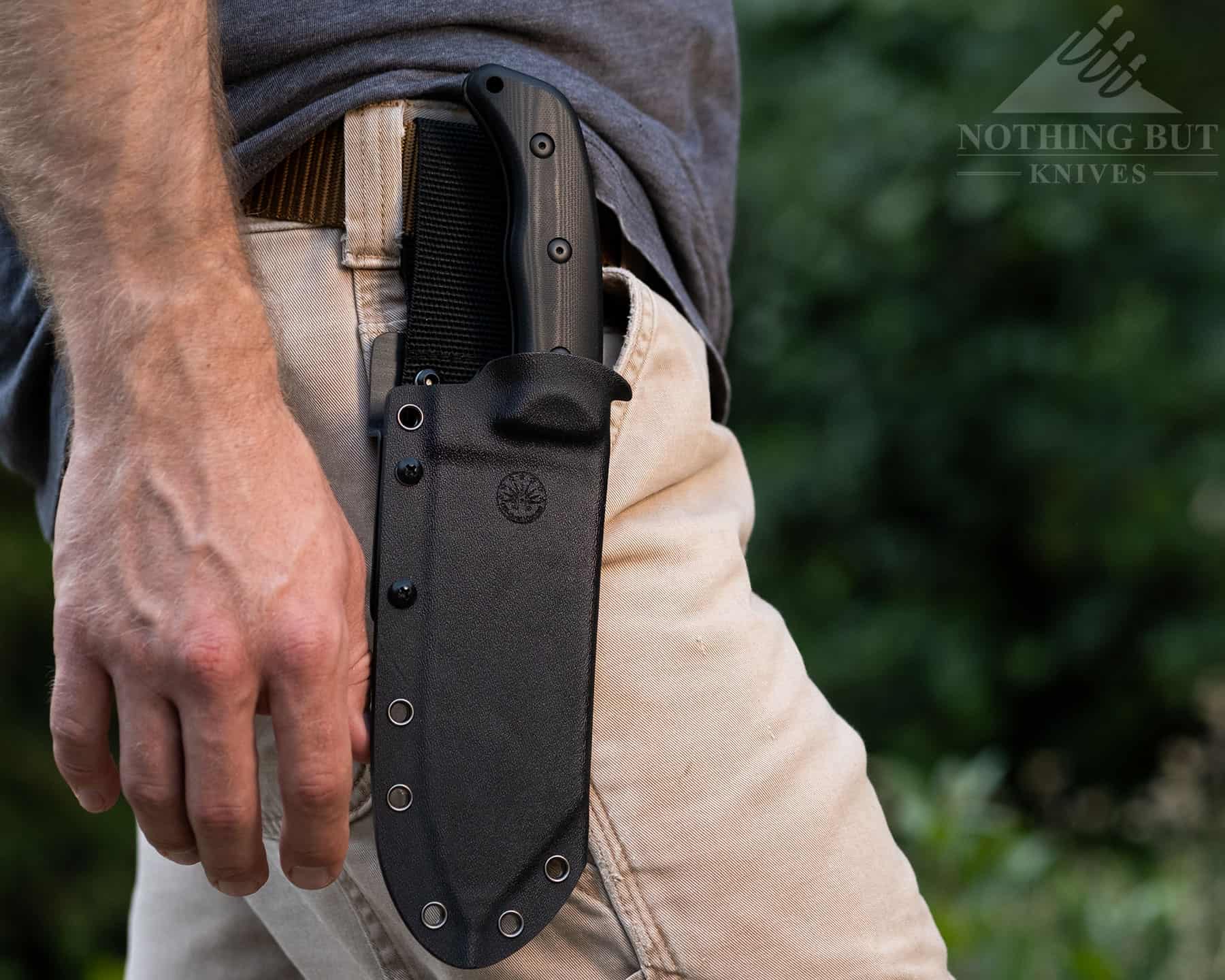
The effortless slicing ability of the Grizzly V2 is what sets it apart, but its kydex sheath is also a standout feature. The sheath sits low on the hip for maximum comfort, and it has a large thumb ramp to make blade deployment quick and easy.
CJRB Silax
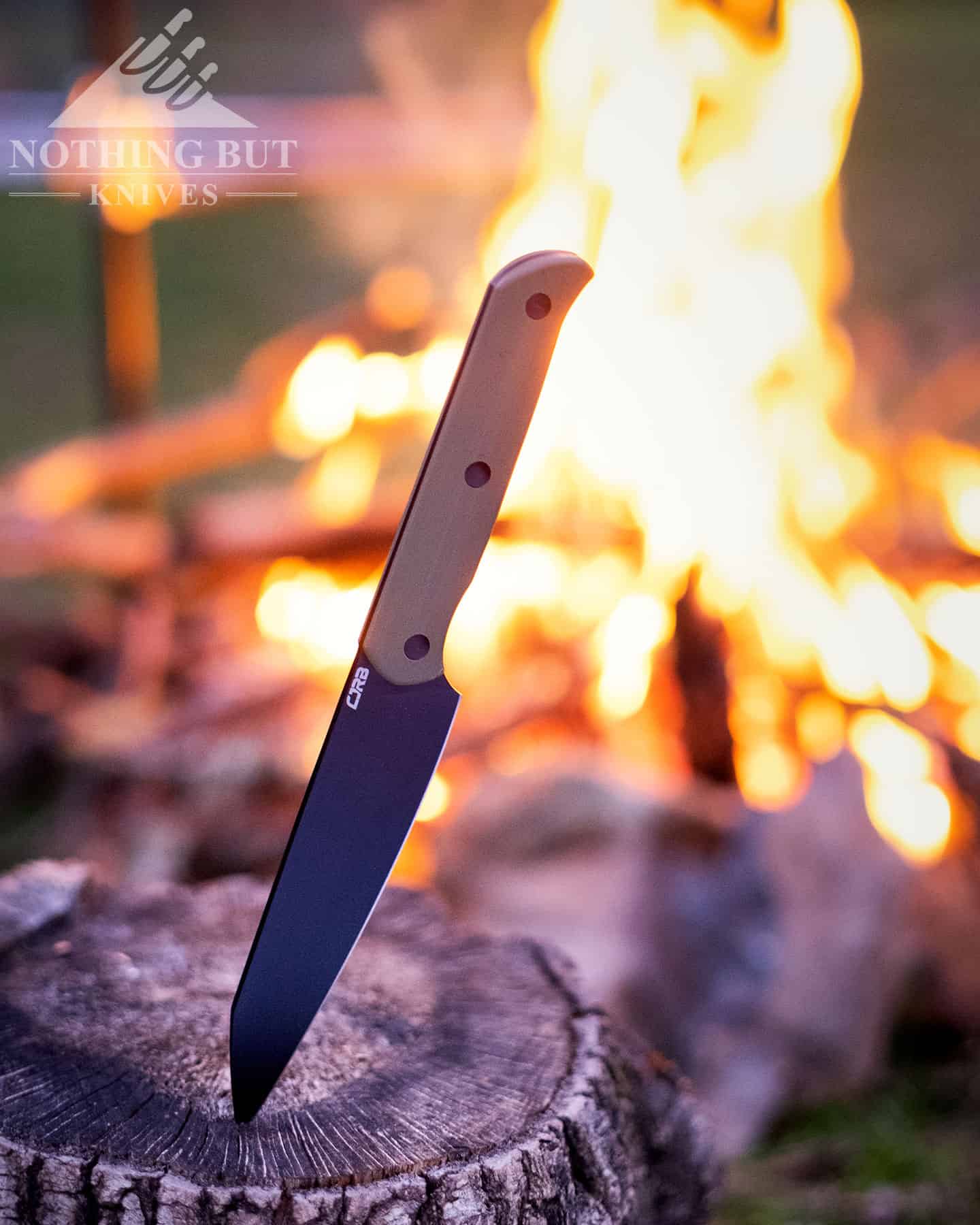
| Overall Length: | 9.75” |
| Blade Length: | 5.25” |
| Blade Steel: | AR-RPM9 |
| Blade Shape: | Modified wharncliffe |
| Blade Grind: | Flat |
| Handle Length: | 4.5” |
| Handle Material: | G-10 |
| Weight: | 4.9 oz |
| Sheath: | Kydex |
| Made in: | China |
| Designer: | Dylan Mallery |
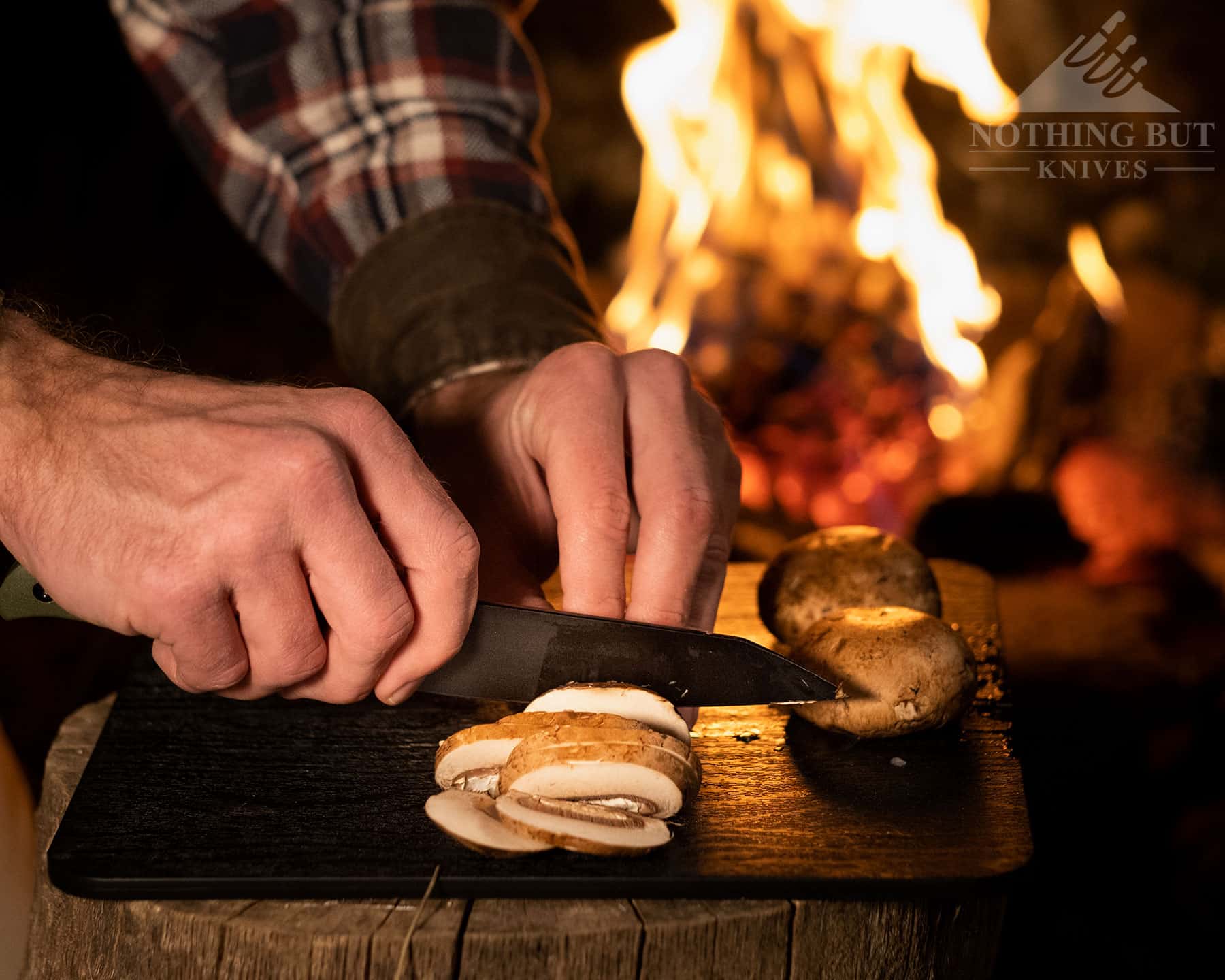
While it isn’t chef’s-knife size, the Silax is one of the few knives on here that I’d use in my kitchen day-to-day. It’s very lightweight and has good balance while having a great edge with manageable steel.
What makes this a good camping chef’s knife is that the steel is tough, but has good edge stability, so there’s a certain ease in maintenance that is especially useful on a long camping trip.
But I love this knife as a whole. Not just for food prep. I love the blade shape because it creates such a strong tip that can get an enormous amount of work done despite the relatively small size. In kitchen-knife terms this is more of a utility knife than a chef’s knife, but the edge is so well done and the handle is so comfortable that I’m more likely to pick this up over the majority of the other picks on this article for a quick cut.
Messermeister Overland Chef Knife
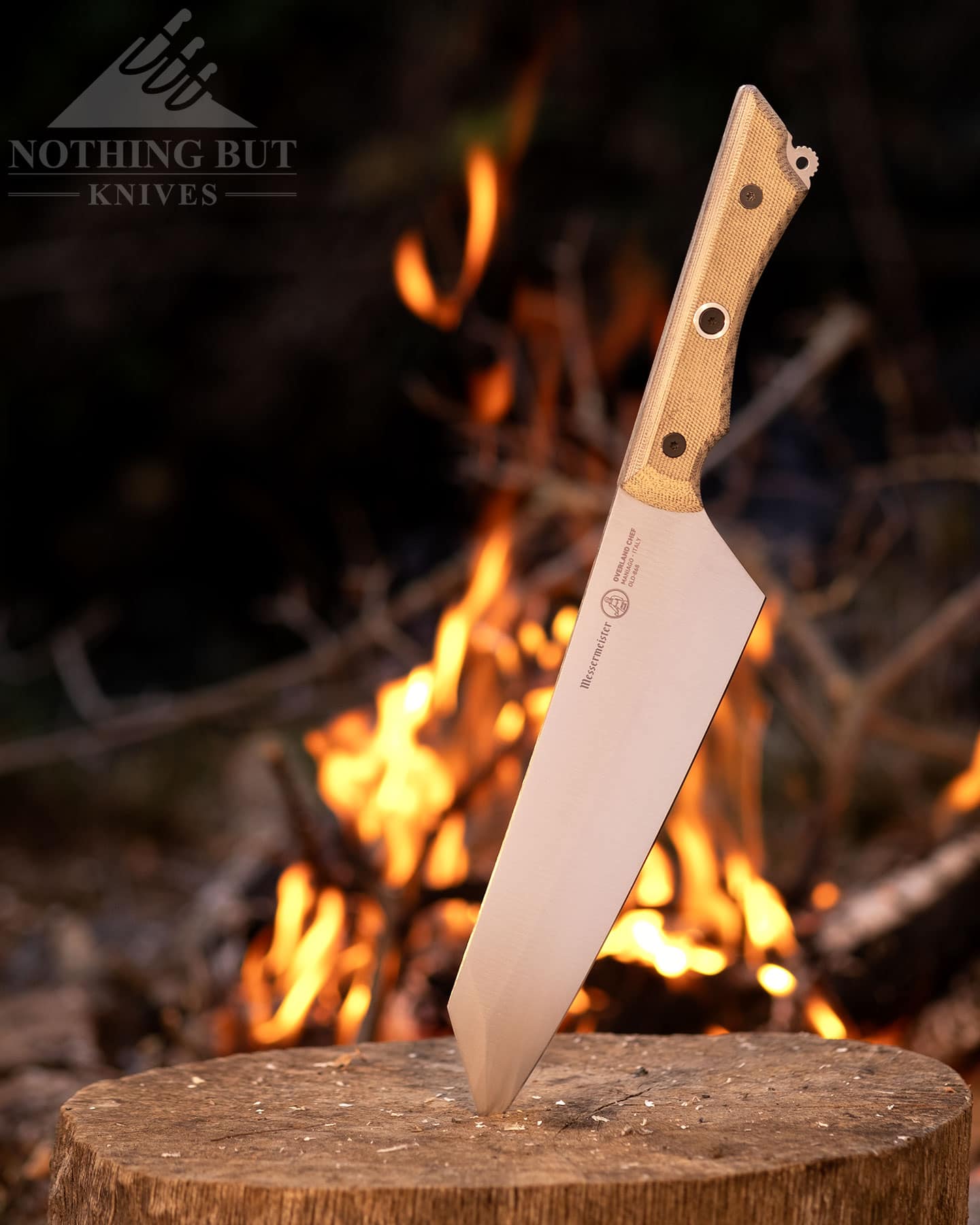
| Overall Length: | 13.25” |
| Blade Length: | 8” |
| Blade Steel: | Nitro Cobalt |
| Blade Shape: | Ballistic clip point |
| Blade Grind: | Facet |
| Handle Length: | 5.25” |
| Handle Material: | Canvas Micarta |
| Weight: | 9.4 oz |
| Sheath: | Leather |
| Made in: | Italy |
| Designer: | Jason Nicosia |
There is a lot to like about the Messermeister Overland chef knife. It has excellent fit and finish, a nitro-cobalt steel blade with amazing edge retention, a hidden bottle opener and a tough canvas Micarta handle. It’s also one of the best knives we’ve tested for cutting raw meat, which is especially useful when camping.
Unfortunately all of this comes at a cost. At $250 the Overland is by far the most expensive knife in this article.
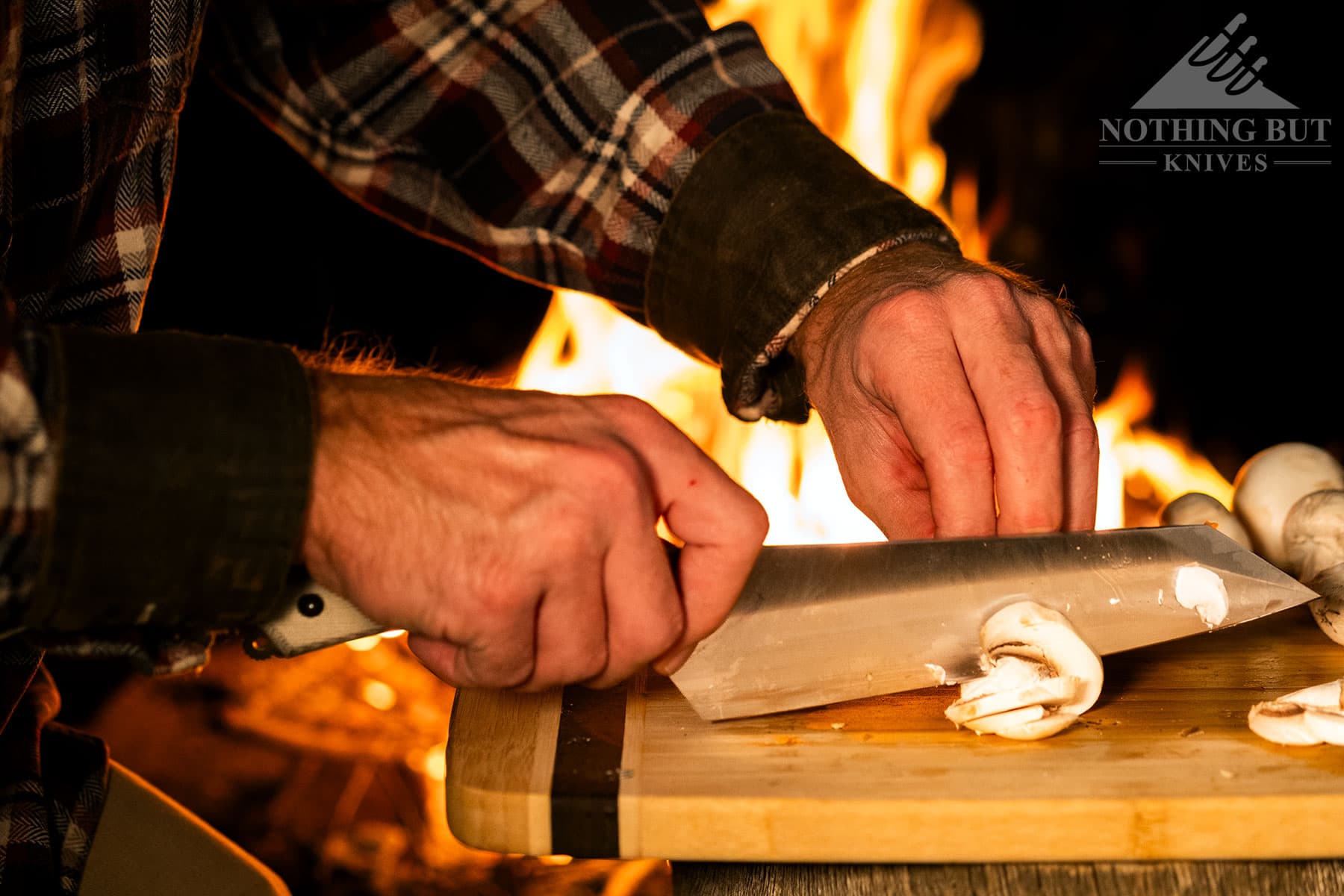
Some of the other knives we talk about here are capable of campfire cooking tasks and other camping relating tasks like chopping or carving. The Overland is really just designed for outdoor food prep, but it does that extremely well. It cuts meat better than most indoor kitchen knives we’ve tested, but its thick spine and low grind give it a little more tensile strength than other kitchen knives.
The 60/40 blade grind makes it a little weird to cut with, but it’s also probably the reason it cuts soft-textured things so well. The Nitro-cobalt steel blade is hardened to 62HRC which means it has a good corrosion resistance, but the edge retention is complicated. It will hold an good edge for a while, but since the grind is so low (compared to normal kitchen knives), it’s going to get harder to keep the edge thin the more you sharpen it.
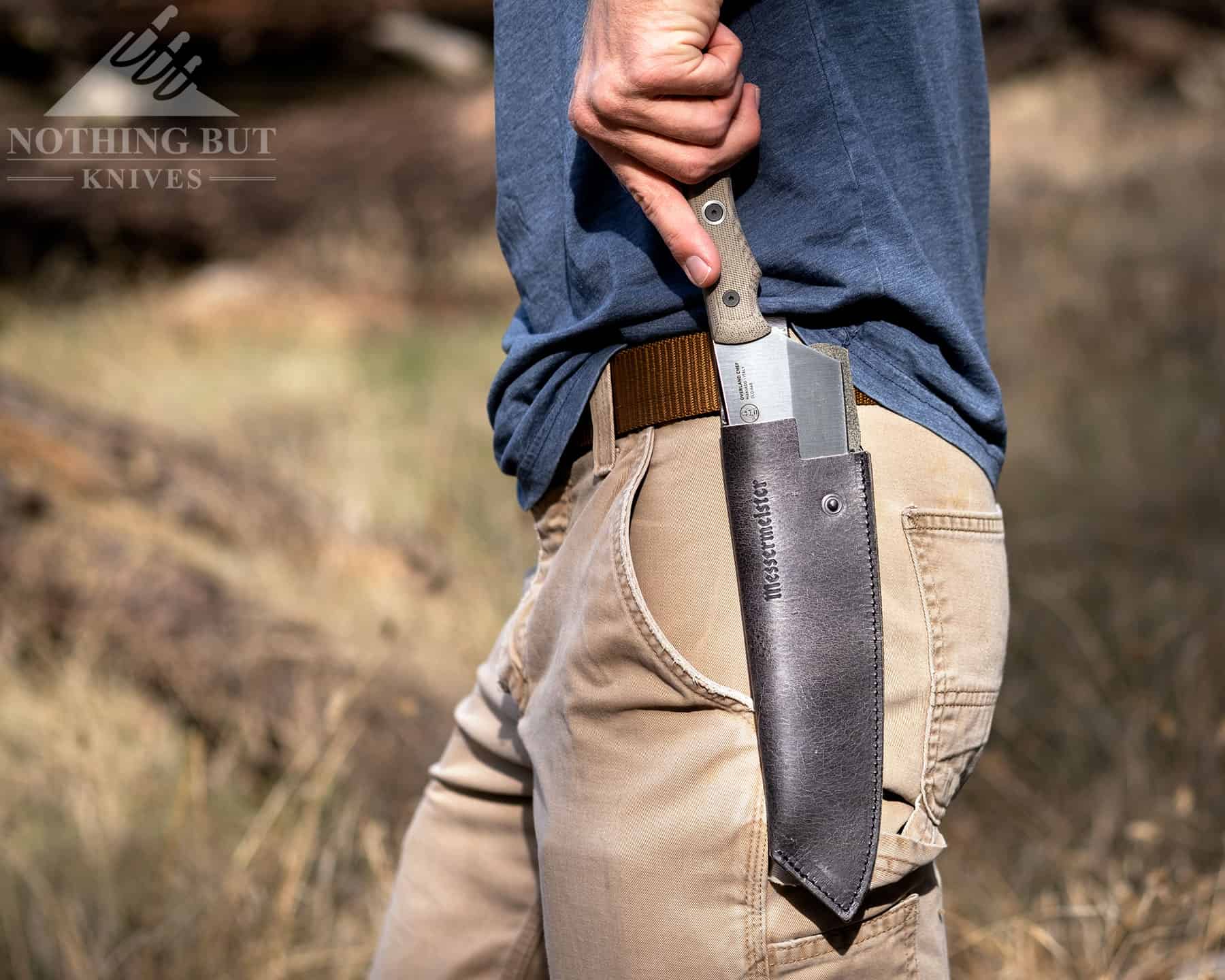
The Overland does not ship with a sheath, but there is a compatible leather sheath that can be bough separately from Messermeister, which pads the price a little more. But it rides surprisingly well for being made by kitchen cutlery company.
Check out our in-depth review of the Messermeister Overland to see if it might be the campfire hero on your next overlanding or camping trip.
The Messermeister Overland is a 2022 Drunken Hillbilly Award winner.
Off-Grid Sierra
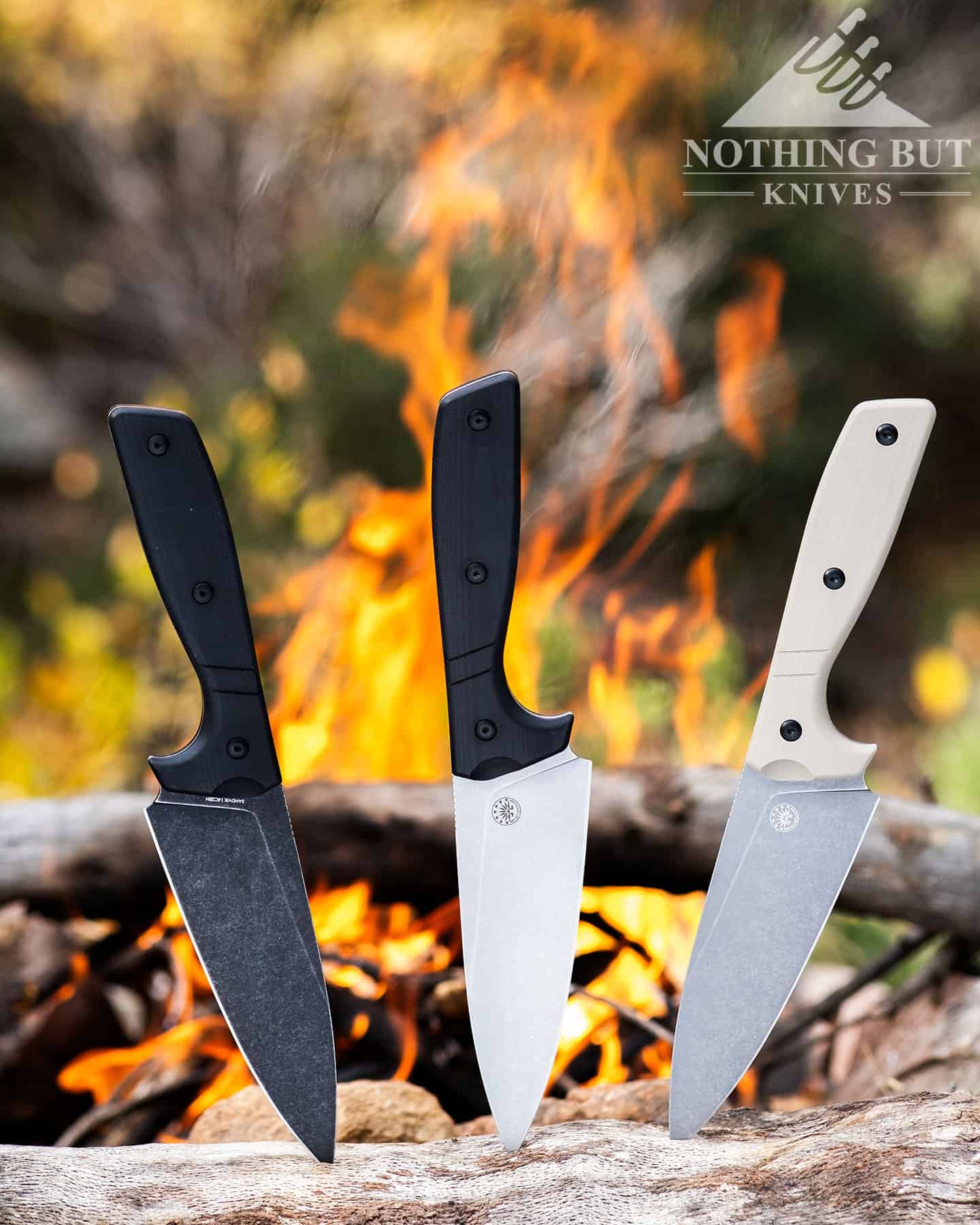
| Overall Length: | 11.0” |
| Blade Length: | 6.0” |
| Blade Steel: | Sandvik 14C28N |
| Blade Shape: | Drop point |
| Blade Grind: | Flat |
| Handle Length: | 5.0” |
| Handle Material: | G10 |
| Weight: | 10 oz |
| Sheath: | Kydex |
| Made in: | Taiwan |
| Designer: | Cary Orefice |
As is usual for Off Grid knives, the Sierra has an aggressive edge that cuts for days. The handle is a little thinner than most other Off Grid fixed blades, though. The way it’s shaped gives you a lot of knuckle clearance in a gorilla grip, and it leaves a bit of room for a good pinch grip.
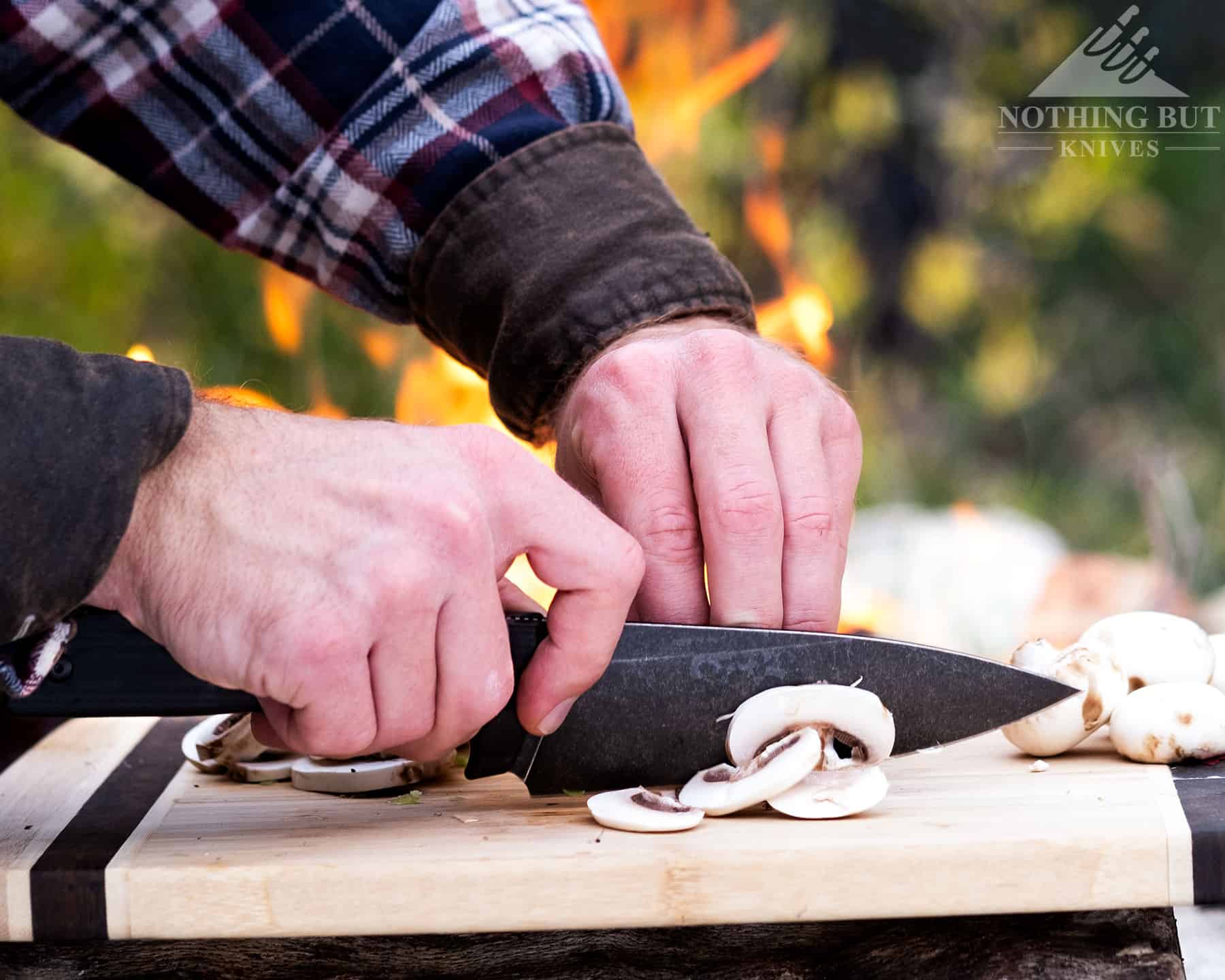
This joins the Off Grid Grizzly as an outdoor knife with food prep in the intended design, which is to say that even though this looks like a mean, overbuilt survival knife in some ways, it was not meant for chopping wood. It’s a great knife for cutting up meat.
Where the Grizzly has a santoku shape that we liked quite a bit for cutting vegetables and other produce, the Sierra leans more French chef’s knife. It has a thin point that’s nice for scoring steak or breaking down whole birds.
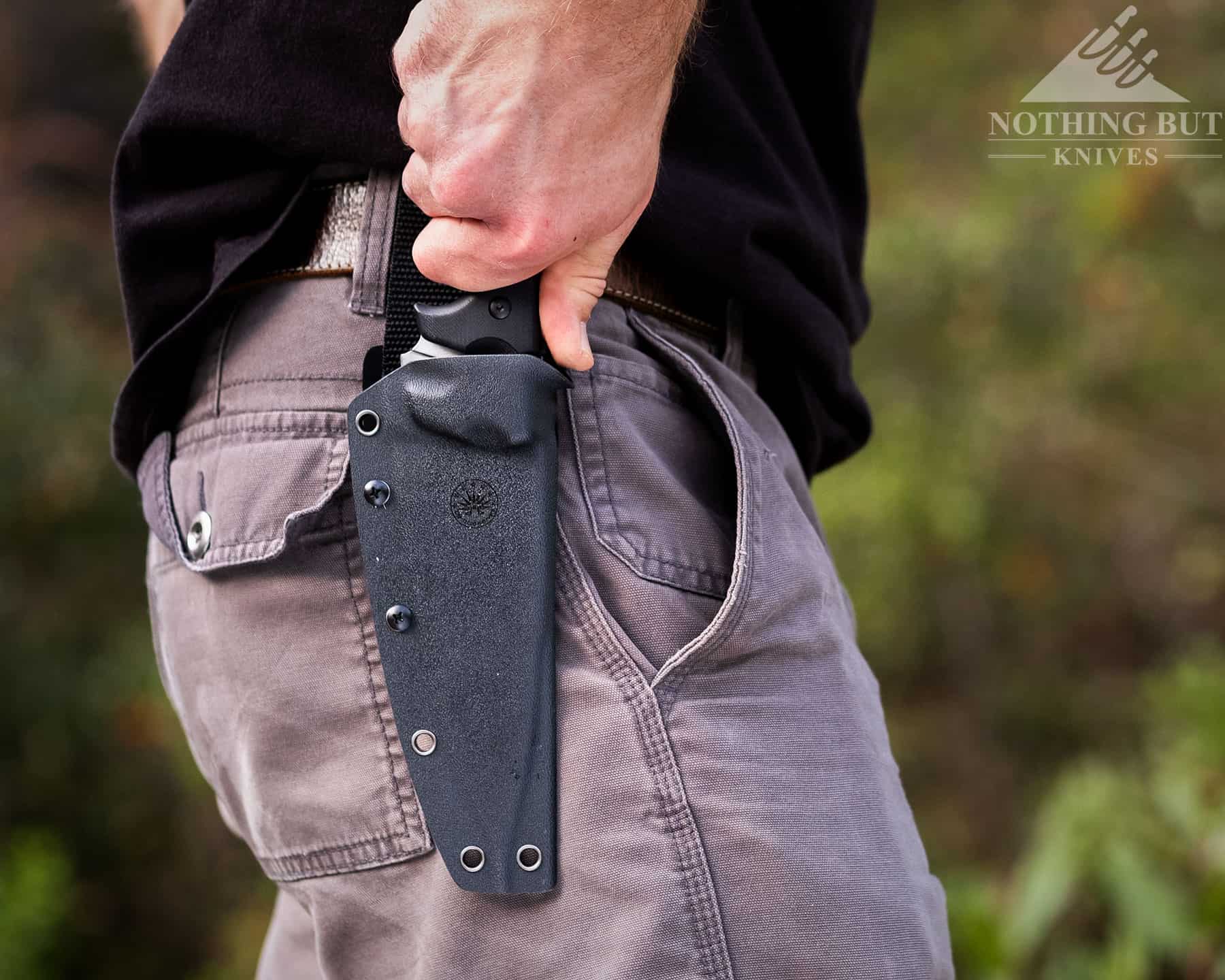
It rides pretty well in the sheath. We found it comfortable enough for wearing around the campsite. It doesn’t flop around much, and it’s nice to draw thanks to the updated thumb ramp Off Grid started putting on all their sheaths. The only thing is the handle is pretty long, so it can still be awkward to draw sometimes and every now and then it would poke at the ribs if we leaned too much one way while sitting or crouching.
Other than that, the Sierra packs easy, rides well on the belt, makes nice, clean cuts, and has a steel that can hold up great against the elements.
The Maxsa Blade
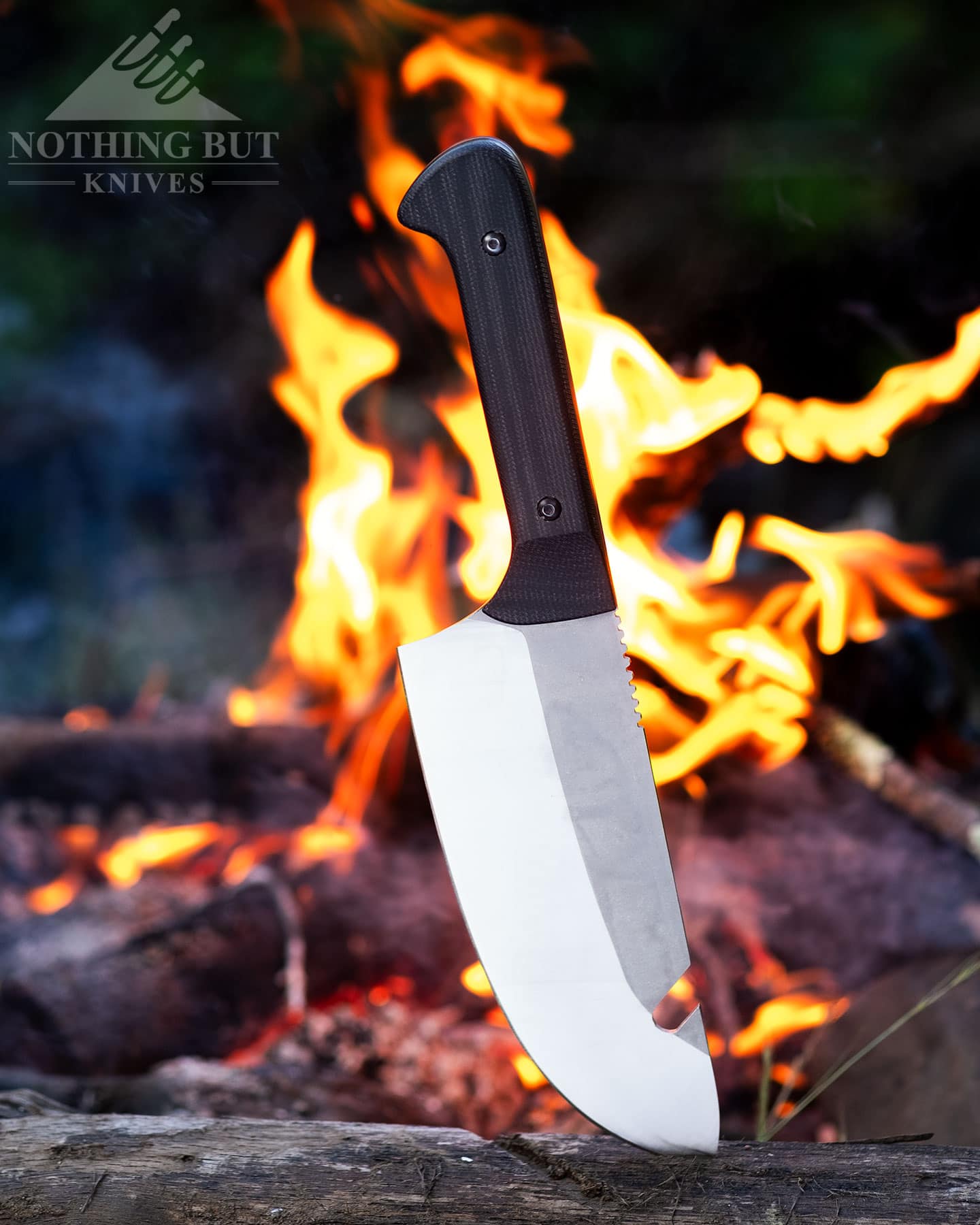
| Overall Length: | 11.8” |
| Blade Length: | 6.5” |
| Blade Steel: | AUS-10 (58 HRC) |
| Blade Shape: | Standard |
| Blade Grind: | Flat |
| Handle Length: | 5.3” |
| Handle Material: | G10 |
| Weight: | 10.8 oz |
| Sheath: | Kydex (no belt loop) |
There’s nothing like a tall blade with a high flat grind and a thick blade stock to give you a wide range of practical utility at a campsite.
The Maxsa Blade is pushed as a “bushcraft chef knife”, so it’s made to chop up some branches before it chops up some onions. And as a bonus, there’s a guthook style notch in the spine that you can use to lift hot pots off the fire and open beers (which, more often than not, is the feature we use the most in testing).
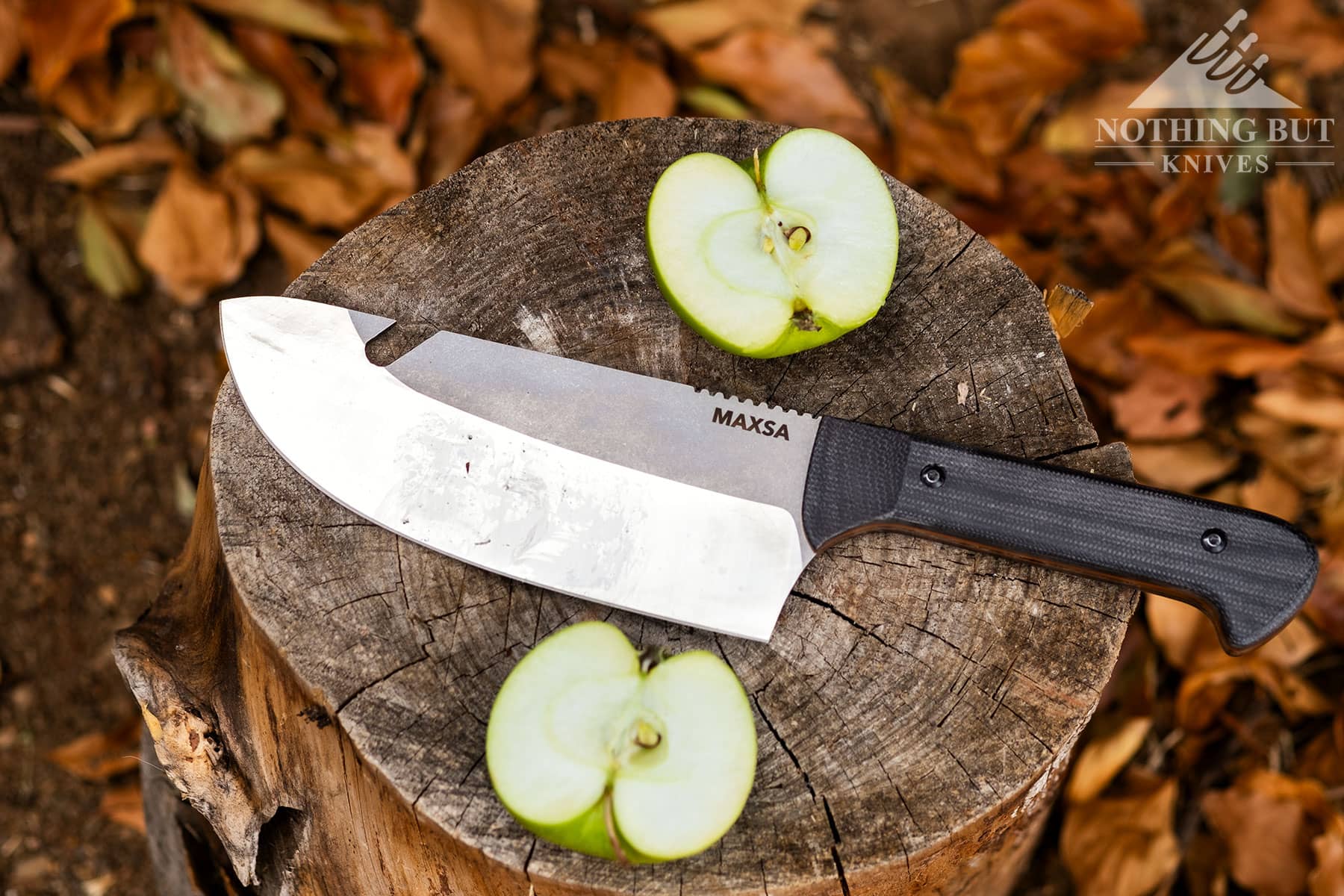
This is a slightly cheaper, stainless alternative to the Condor Bush Slicer. It might cut food a little better than the convex grind on the Bush Slicer, but there’s a hell of a lot less sheath, and the Maxsa’s G10 handle doesn’t quite match the comfort of thick Micarta scales.
Most of the food cutting we did with it looked pretty rustic, but we still managed a decent meal. Chopping was a blast with it, and anyone who’s a Cold Steel fan can tell you that a chunk of AUS10 steel is capable of taking a lot of abuse.
Check out our in-depth review of the Maxsa Blade here to learn more.
BPS Knives Rosemary
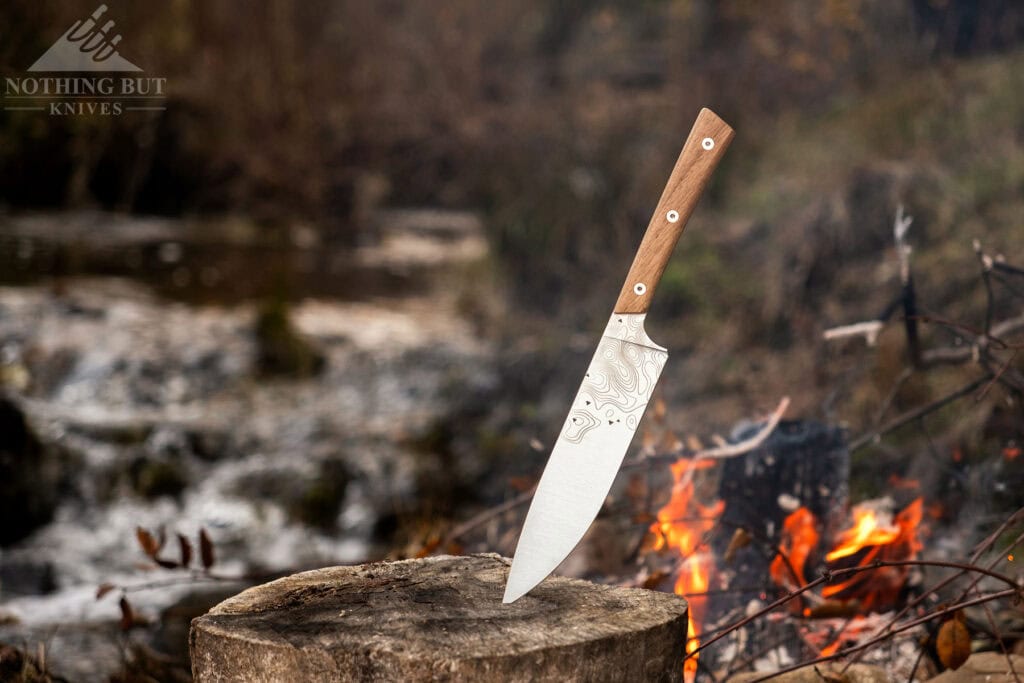
| Overall Length: | 13” |
| Blade Length: | 7.7” |
| Blade Steel: | 5Cr14MoV (HRC 56 – 57) |
| Blade Shape: | Western chef |
| Blade Grind: | Flat |
| Handle Length: | 5.3” |
| Handle Material: | Walnut wood |
| Weight: | 6.17 oz |
| Sheath: | Leather (no loop) |
| Made in: | Ukraine |
This is the budget option that you can get a lot of mileage out of. The Rosemary actually has a pretty typical kitchen knife profile that feels nice in a pinch grip. Its claim here as a camping chef’s knife is that mostly in that the steel is tough, the grind is a little bit thicker, and it comes in a nice leather sheath.

While it doesn’t exactly have a refined cutting action (it’s just a bit too thick behind the edge) it does have a steel that’s easy to work with. The knife is otherwise well constructed: The handle feels solid, and its thin profile makes it light and easy to grip. Between that and the price, it’s worth taking a little bit of time to thin out the edge geometry (unless you plan on doing a little bit of bushcraft work with this knife, in which case the edge might be fine as is).
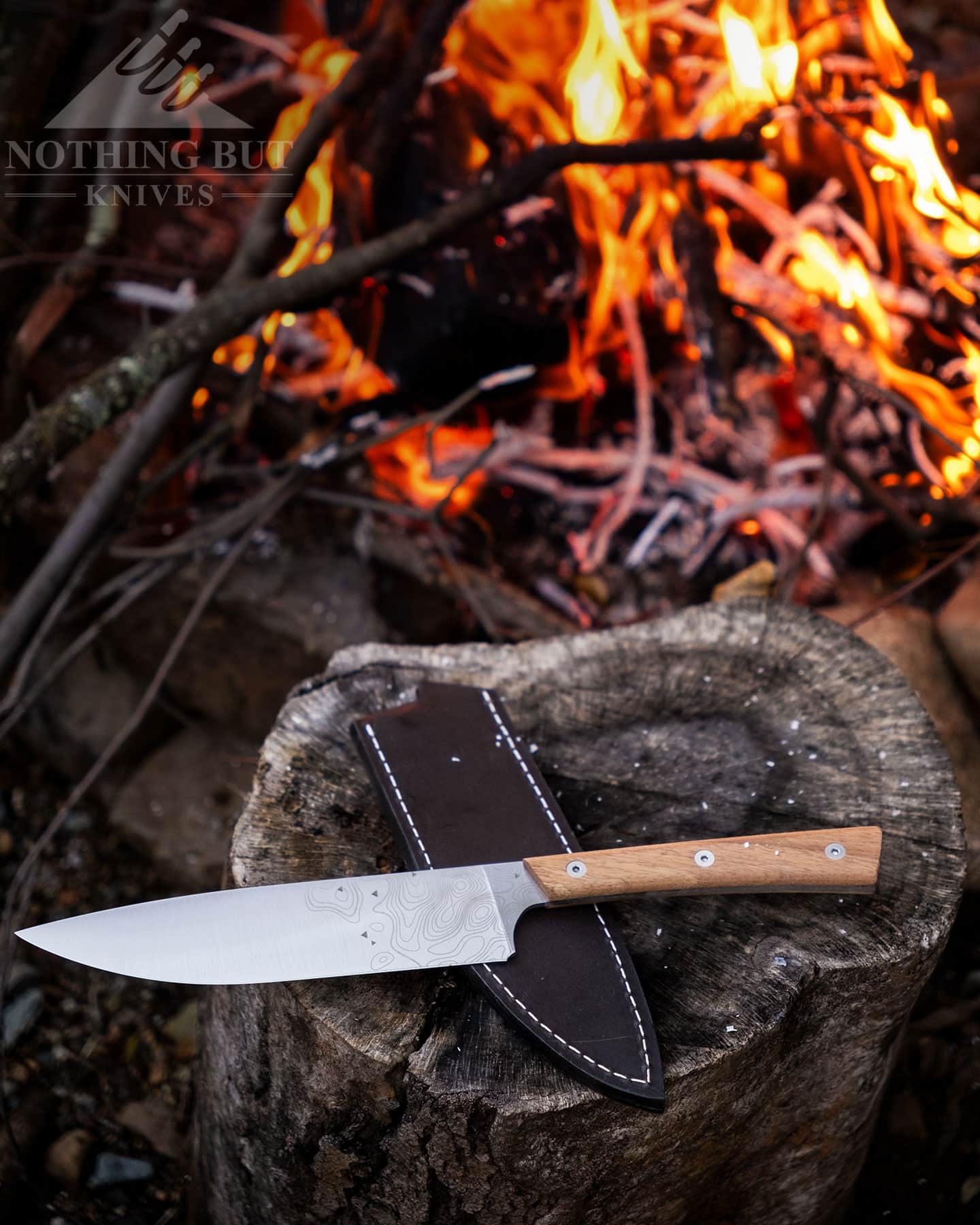
It almost feels like it would belong in the Old Hickory set, with the handle, cost-effective nature, and general agreeableness to a strop and a low grit stone. To the point that I’d recommend this as a decent alternative if you’re having trouble finding the Old Hickory stuff in stock.
Condor Bush Slicer
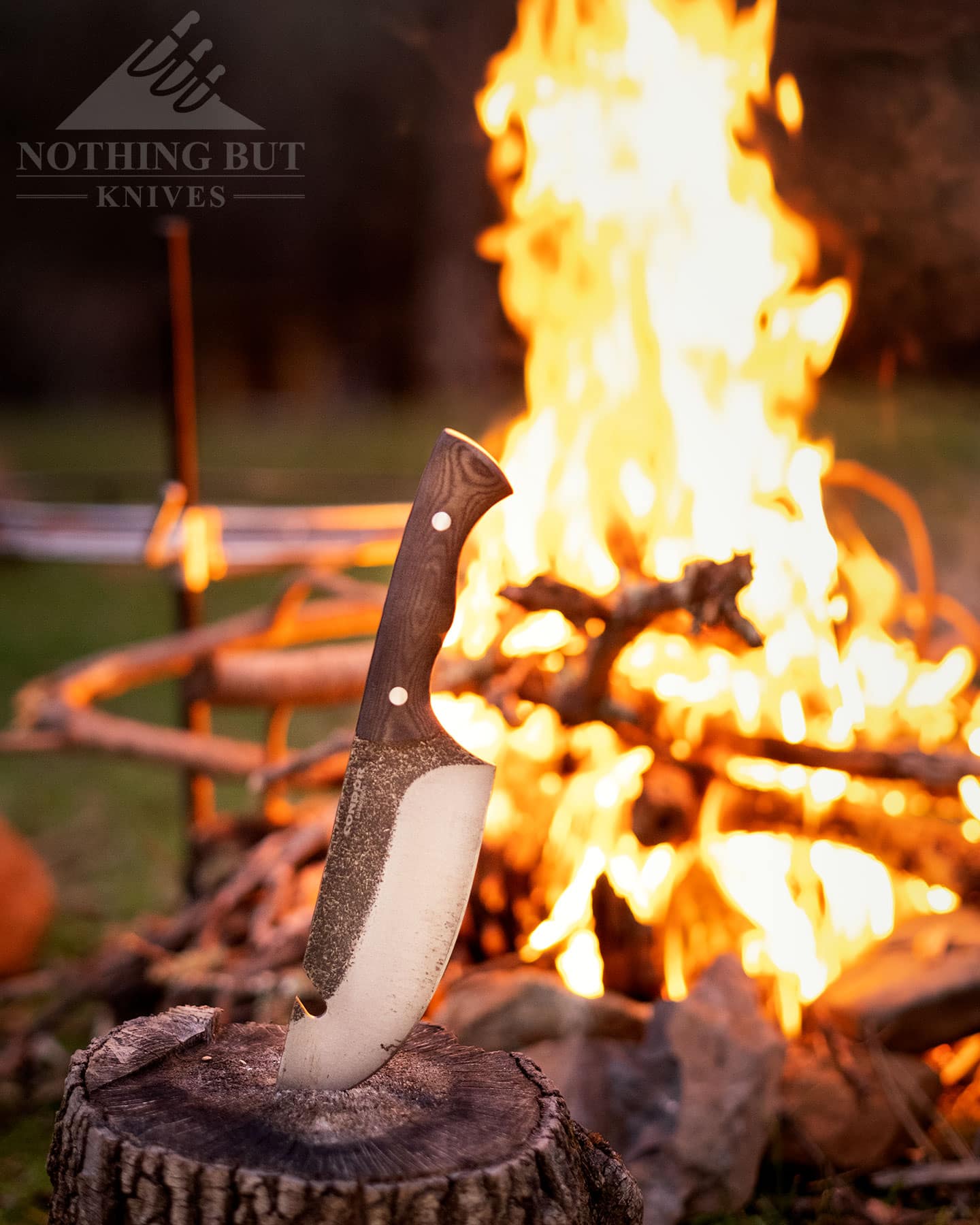
| Overall Length: | 11.75” |
| Blade Length: | 6.5” |
| Blade Steel: | 1075 |
| Blade Shape: | Standard |
| Blade Grind: | Convex |
| Handle Length: | 6.5” |
| Handle Material: | Micarta |
| Weight: | 10.98 oz |
| Sheath: | Kydex w/ leather strap |
| Made in: | El Salvador |
| Designer: | Julio Diez |
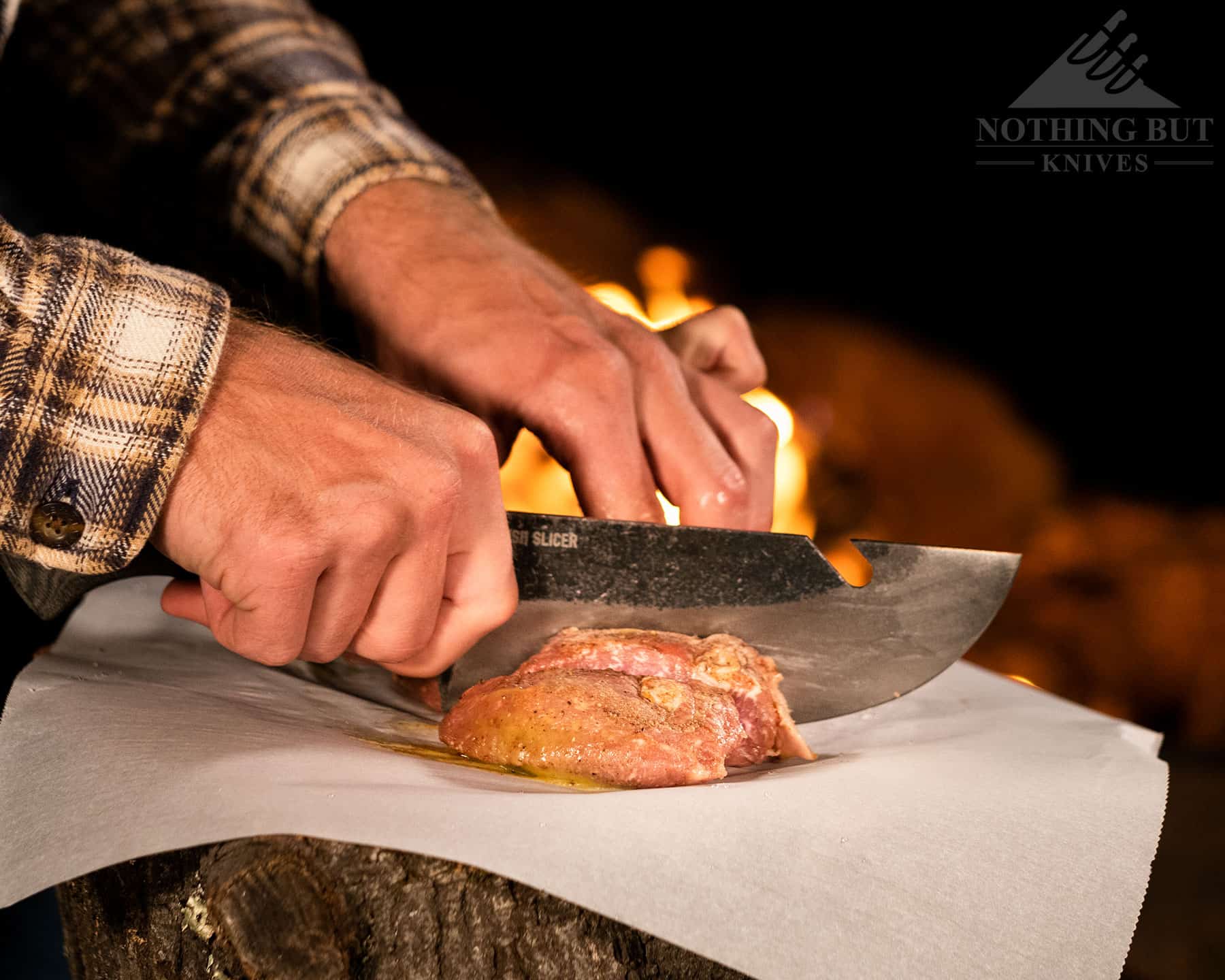
The “slicer” in the name of this knife is misleading. It’s more of a bush chopper. Slicing can get tricky with it, especially where food is concerned, but there’s so much edge to work with that you can get the job done one way or the other.
The real benefit here is that the Bush Slicer is the only knife you need to take. You can chop wood and start the fire that you’re going to cook on, and while the food might not always look pretty or delicate if cut with this knife, it will be cut and the benefit of having a chopping edge on a tall blade that can double as a spatula makes cooking on the pan pretty nice.
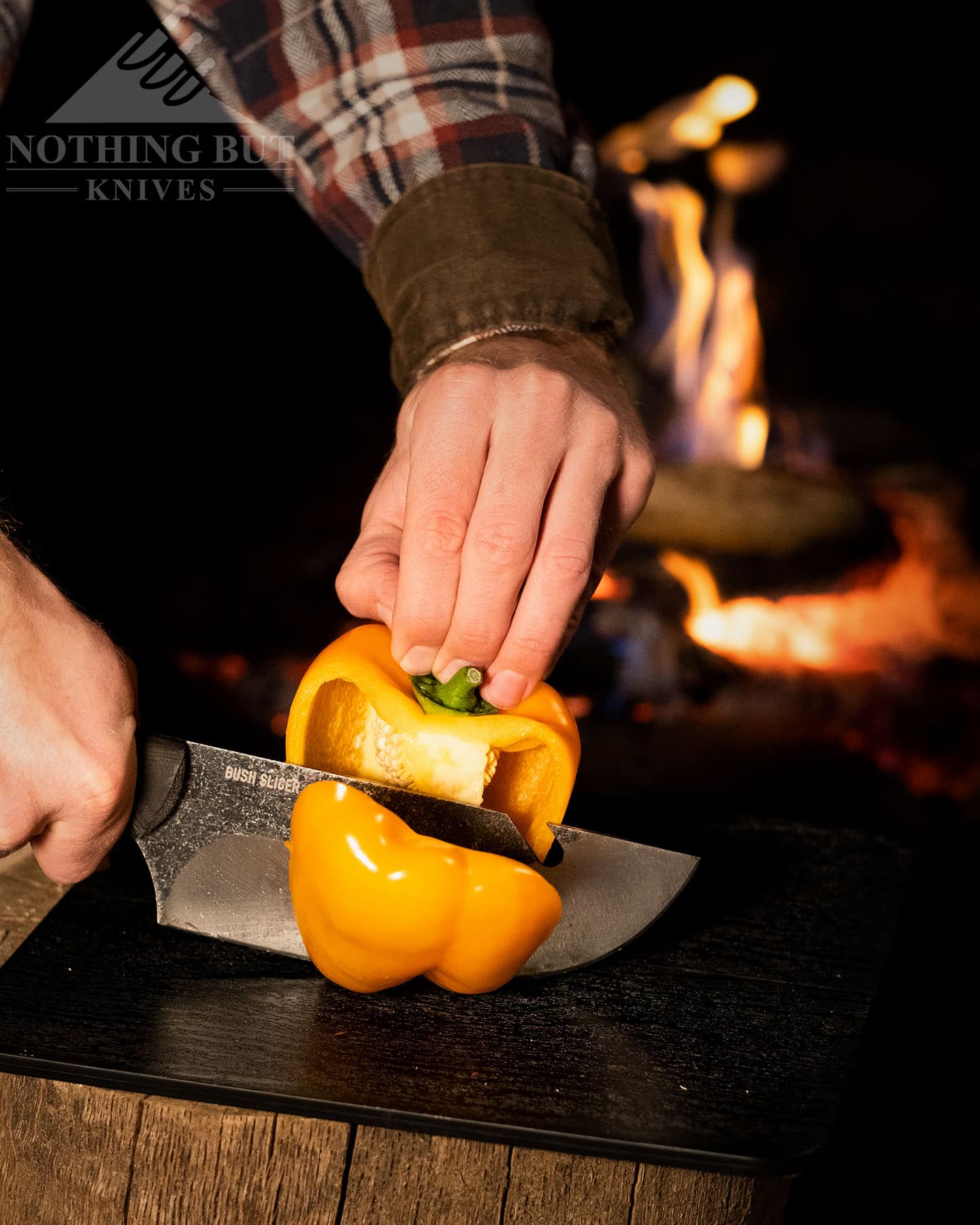
It’s also nice that I never feel particularly concerned about damaging the edge even when I’m stirring food on a cast iron pan because 1075 steel is pretty easy to work with, and there is an enormous amount of it here in a convex grind. In a worst case scenario I can just reprofile the blade, but until then there’s something to be said for managing your entire campsite, from tent stakes to beef steaks, with a hefty cleaver.
If you want to learn more about the Bushslicer, check out our in-depth review.
Civivi Kepler
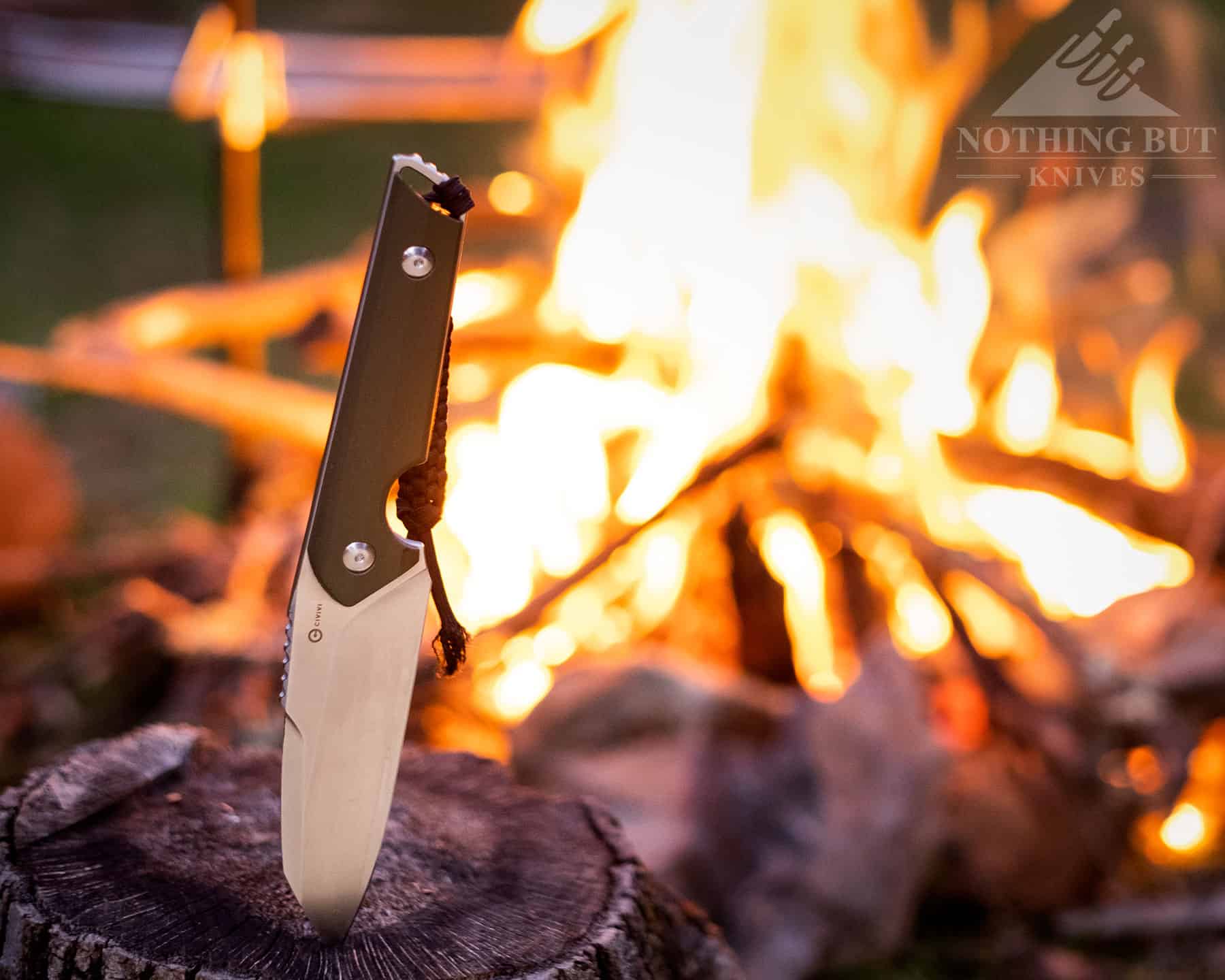
| Overall Length: | 10.0” |
| Blade Length: | 4.5” |
| Blade Steel: | 9Cr18MoV |
| Blade Shape: | Wharncliffe |
| Blade Grind: | Compound flat |
| Handle Length: | 5.5” |
| Handle Material: | G-10 |
| Weight: | 7.7 oz (11.25 oz w/ sheath) |
| Sheath: | Kydex |
| Made in: | China |
| Designer: | Maciej Torbe |
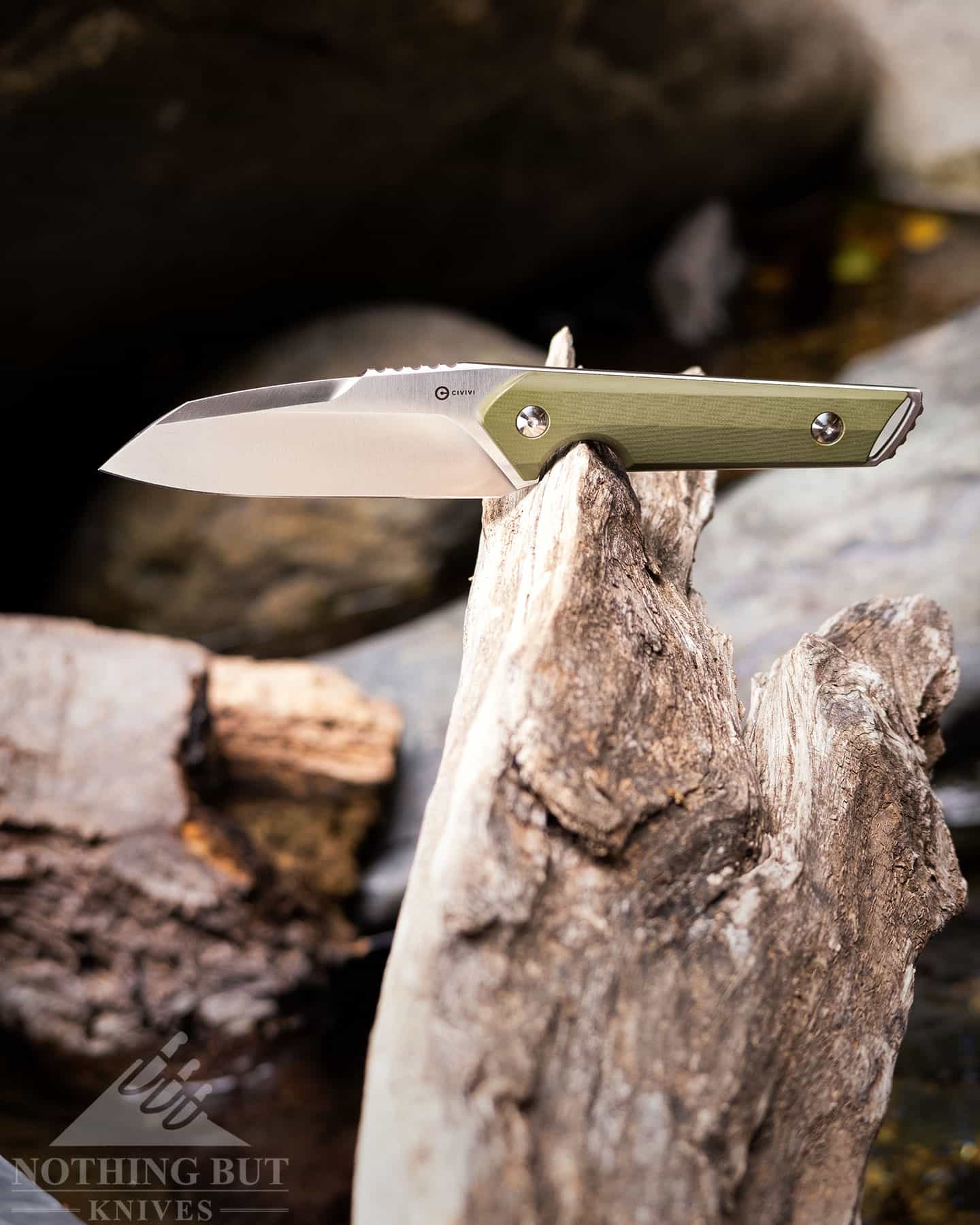
The shape is mostly what makes me like the Kepler for food prep. There’s a lot of knuckle clearance, and you can get a fairly comfortable pinch grip on this. Also the cleaver shape provides some of the same strong-point benefits as the Silax and the Grizzly.
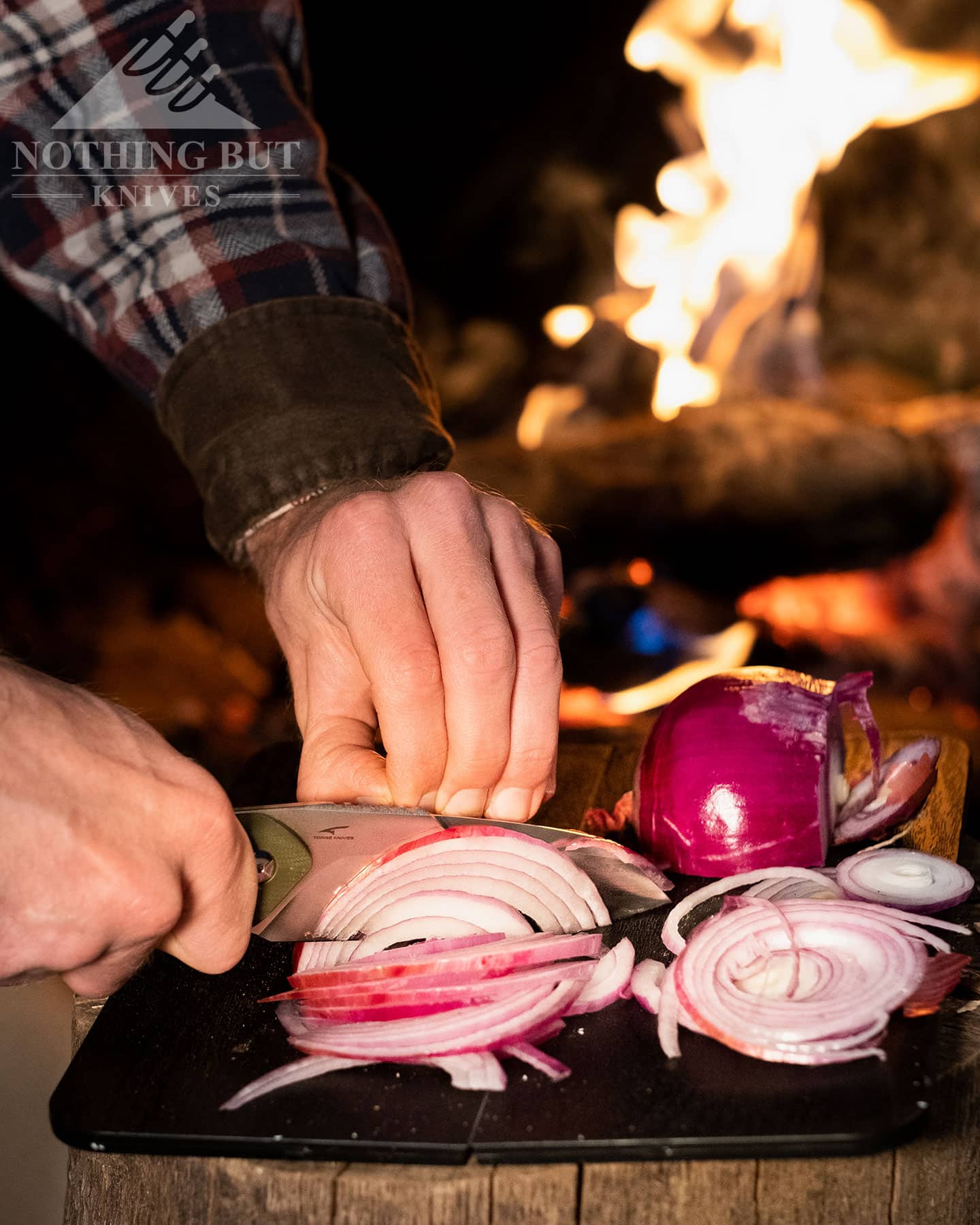
Except that the edge grind is much wider. This was not designed for food prep, after all. In that sense it falls more in line with the Bush Slicer, but it has the benefit of stainless steel. The blade is impressively durable and a mean chopper, but it takes some stropping to get this into any kind of satisfying food-cutting shape.
Even then the angle of the grind is so wide that it has a habit of making your cut turn on larger, harder foods like onions and apples. But so long as you’re content with a rustic spread, the Kepler can take you pretty easily from a pile of meat and vegetables to a halfway respectable sandwich melt.
I wrote an in-depth of this review of the Civivi Kepler if you want to learn a bit more about this knife.
Kitchen Perfection Chef Knife
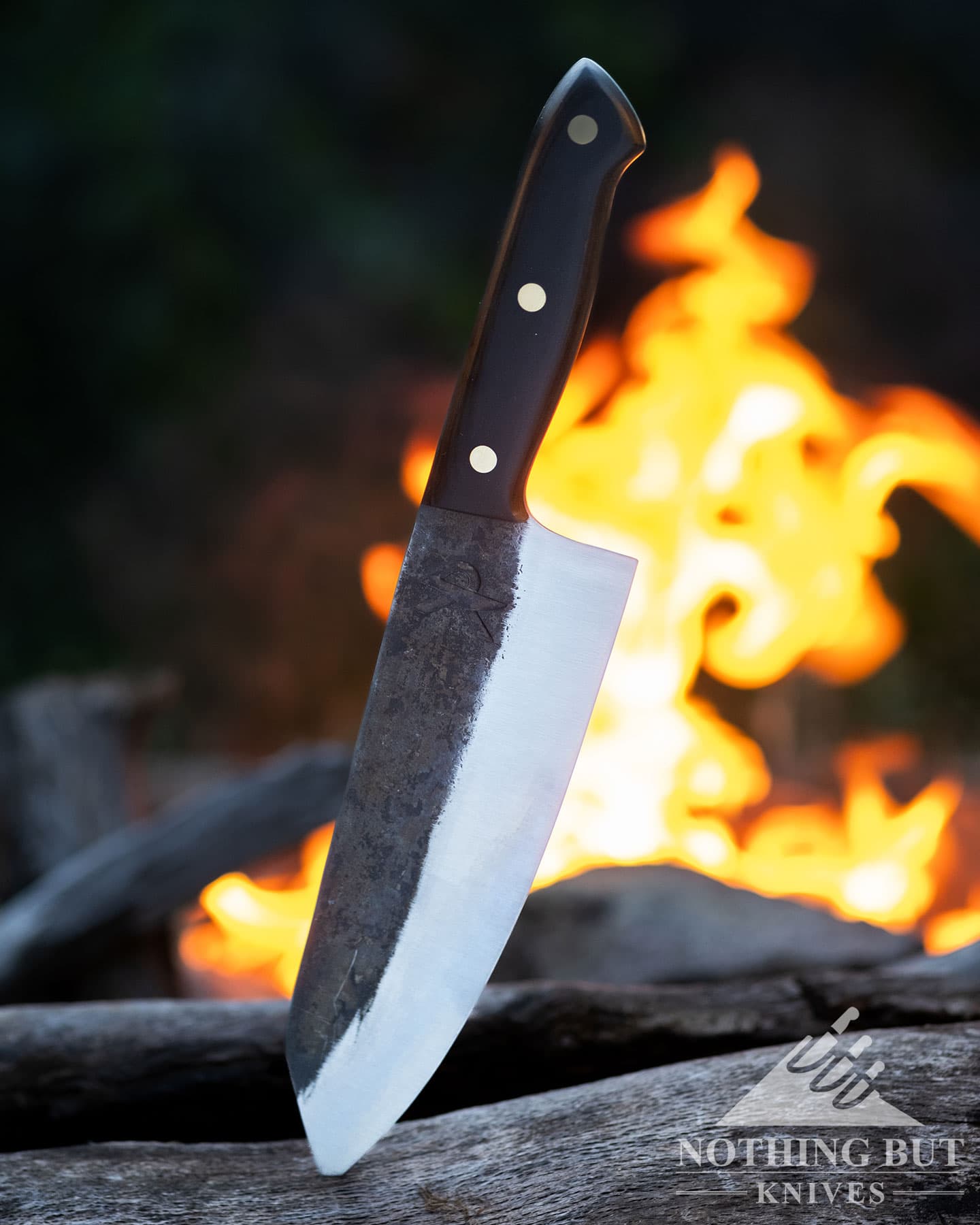
| Overall Length | 12.25” |
| Blade Length: | 7.78” |
| Blade Steel: | High carbon |
| Blade Shape: | K-tip |
| Blade Grind: | Flat |
| Handle Length: | 4.75” |
| Handle Material: | G-10 |
| Weight: | 10.3 oz |
| Sheath: | Cloth w/ button strap (no belt loop) |
| Made in: | China |
For a knife that has all the markings of a cheaply-made cash grab, this is actually a solid outdoor cooking knife.
The standout element to me is how comfortable it is. It has a rounded handle and a crowned spine, so there’s really no bad way to hold this knife. It’s good in a pinch grip, it’s good in a hammer grip, and the shape is neutral enough that you can hold it anyway in between just as comfortably.

A word of warning: I don’t know what the steel is, but it’s high carbon with all the care requirements that brings. On the bad side, that means you need to watch out for rust. Keep it dry. Always wipe it off quickly after using it, especially if you cut anything highly acidic.
The good side is that it’s a tough blade with an edge that’s easy to get into hair-shaving sharpness with a good strop. The blade is also quick to take on a patina. That could be a downside for some, but I’ve grown to like the citrus rainbow that’s developed on mine. Check out our full review of Kitchen Perfection’s chef knife here.
OKC Camp Plus Kitchen Folders
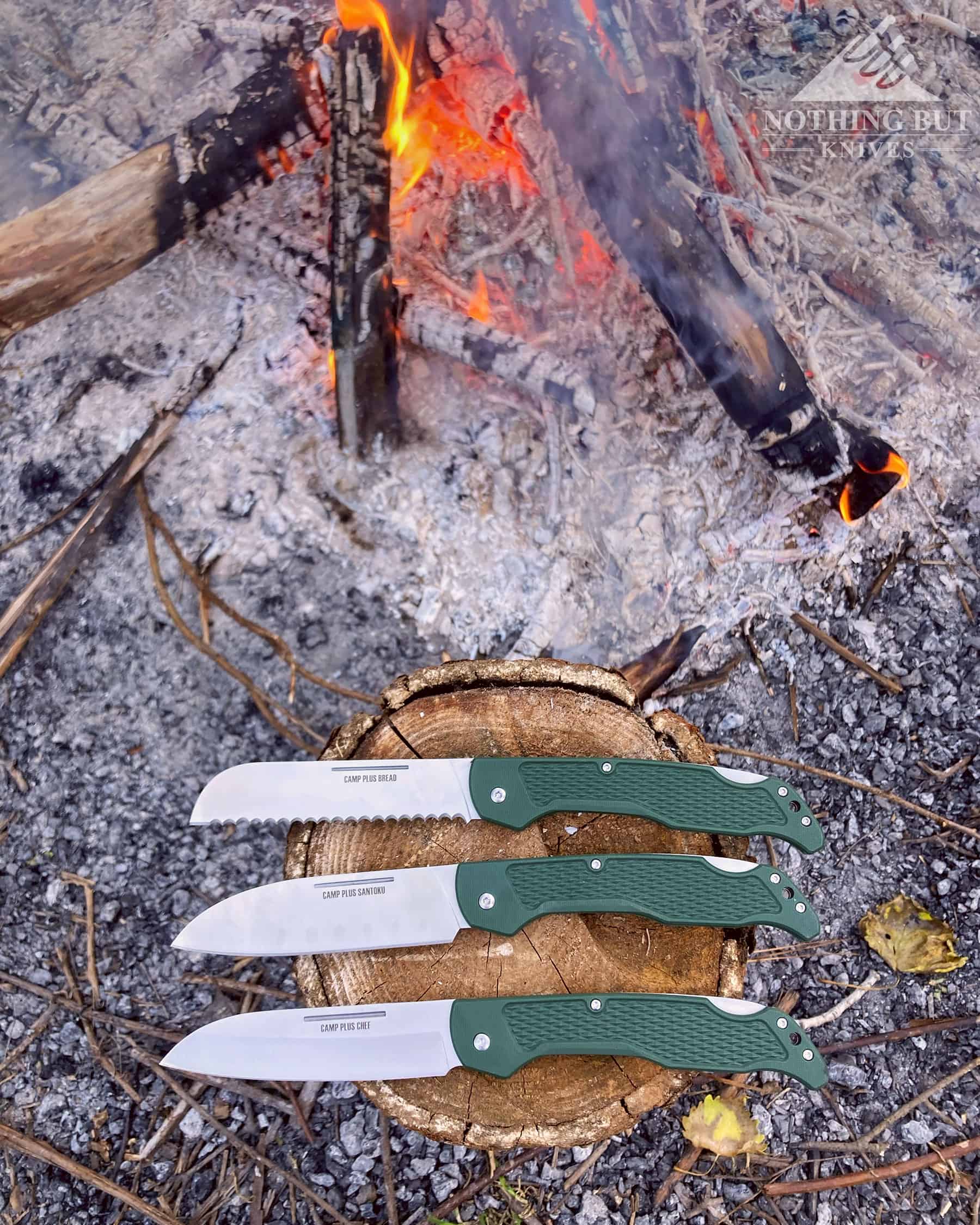
| Overall Length: | 9.51” |
| Blade Length: | 4.25” |
| Blade Steel: | 420 |
| Blade Grind: | Chef (Hollow) Santoku (Flat) Bread (Flat) |
| Handle Length: | 5.5” |
| Handle Material: | GFN |
| Made in: | China |
| Weight: | 3.6oz |
This is the design Messermseister needed for their Adventure Chef knife: a smaller backlock folder with a reasonably sized handle that manages to fit the blade without creating too much complication with the grip. They’re not exactly optimized for knuckle clearance, but they’re still enormously usable knives for the price.
Ontario’s trio of Camp Plus kitchen folders hits a lot of other points right for fireside camping. The blades are thin, but they’re made with a soft steel that doesn’t feel like much of a risk around rough terrain; each knife is very lightweight and pretty comfortable considering the material and purpose they’re working with; and all three knives together end up being cheaper than every other knife on this article right now (with the exception of the Old Hickory butcher knife, which is also happens to be made by Ontario).
None of these knives are going to be winning performance awards, although they do cut pretty well out of the box and that plain 420 steel can take a pretty mean edge. But Ontario Knife Co. excels at making absurdly tough, cost-effective designs that somehow end up getting used twice as much as anything else I own.
What Makes a Good Outdoor Chef’s Knife

A good set of criteria to use for a food prep knife on the campground is thin edge geometry, toughness, and mobility. So basically, a knife that emphasizes food preparation with a nod to toughness that’s easy to carry or pack.
The importance of each of those elements will probably be different depending on what kind of camping you’re doing, though. When we tested all these knives, mobility usually wasn’t quite as important to us as toughness, but we always have to prepare for the fact that we are not the most careful people, and things happen: knives get dropped, and rocks find their way onto the cutting board (assuming we remembered to bring a cutting board in the first place).
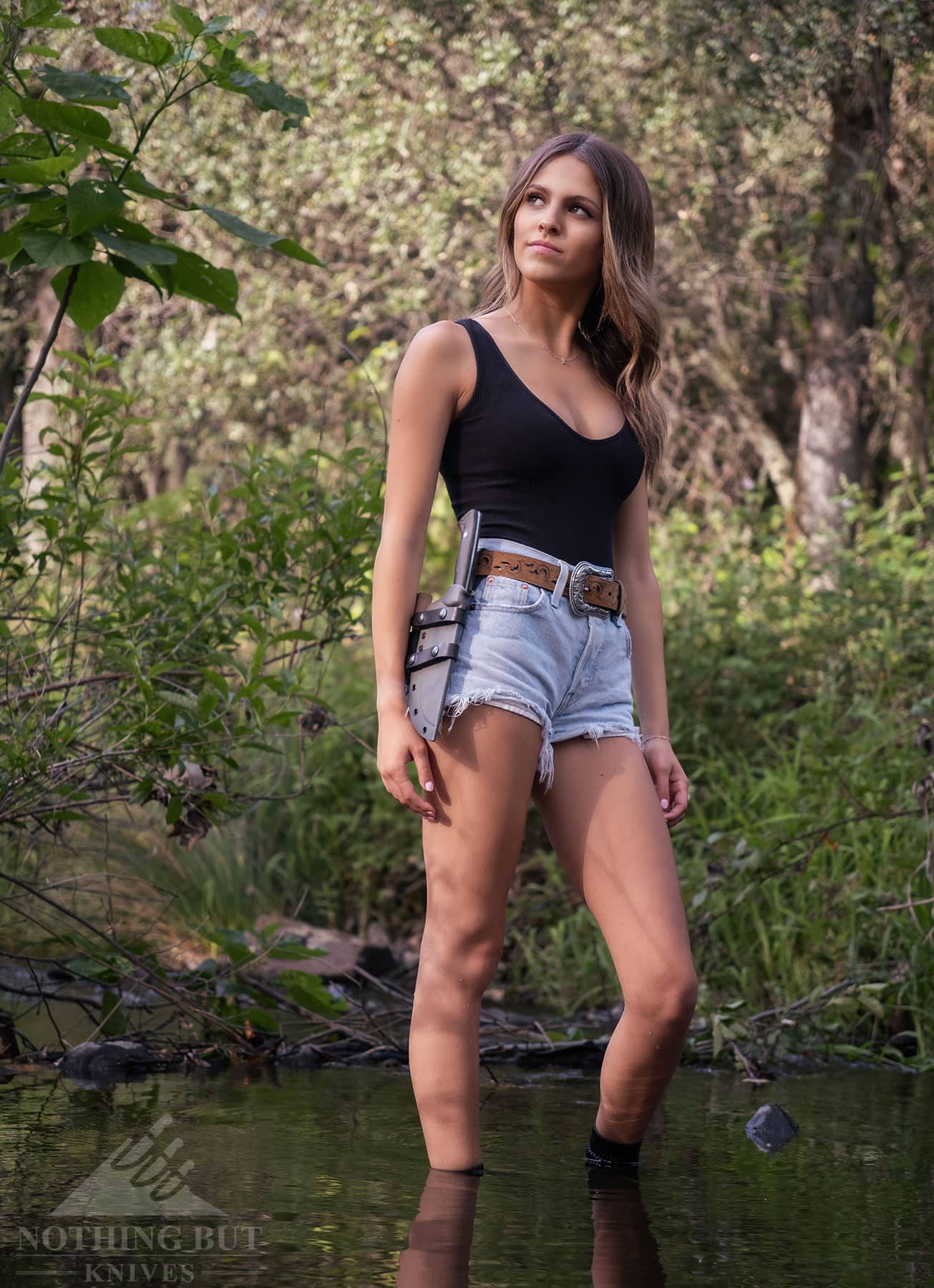
You could simplify it as any knife you’re brave or dumb enough to take to a camp site. I know people who camp with fully custom chef’s knives packed in a knife roll, but even they usually take that knife because something makes it tougher than the other stuff in their collection.
If you’re not into the whole hybrid-use thing, though, you can always just get a regular kitchen knife.
For a reasonably priced chef’s knife, you can check out some of the brands in our Best Kitchen Sets Under $200 (a Buck or a Victorinox wouldn’t be bad options). Or if you want some of that sweet Japanese kitchen cutlery, we have a whole article about that (we’d personally recommend a MAC or Tojiro for this kind of thing).
Easy Packing

It either needs to be able to pack up cleanly in a bag or on our belt. Ideally it can do both. Anything that comes in its own belt sheath is a plus, but it’s good enough if it can be tucked into a backpack or box without taking up much space.
Sheaths are a big deal for us because we tend to have a lot of gear, and it’s easier to keep track of the food-prep knife when it’s strapped to our hip. If a big thin knife had a kydex sheath we could either strap to the belt or run paracord through, it had a greenlight to chop up onions in the woods.
Knuckle Clearance
Just like in the kitchen, we need some room for our hands at the campground. There are usually ways around needing that clearance when you’re cutting something on a stump, but it helps a lot when a knife has a tall blade that helps keep the hand clear of whatever we’re using as a cutting board.
Durability and Versatility
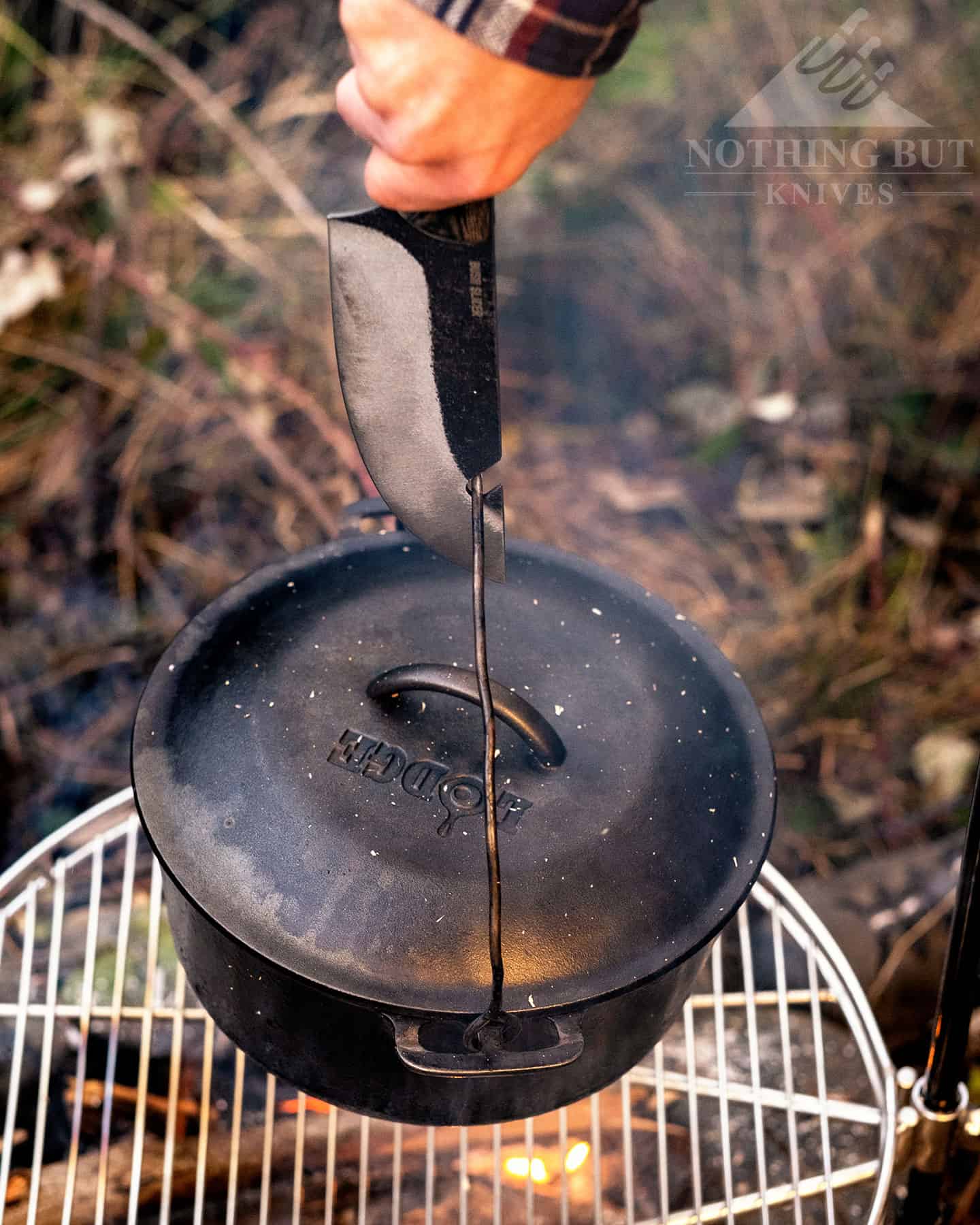
A lot of our picks tend to be knives made of steel that’s tough and easy to fix up and reprofile.
It’s not that we want our camping chef’s knives to be able to chop and baton (although some of our picks can), but when we use a knife for cooking outdoors we tend to use the one knife for food prep and cooking and usually a little extra. A lot of the time we can’t count on having much empty table space for extra knives and tools lying around, so one knife might need to be the fork, spoon, and spatula.
Thin Edge
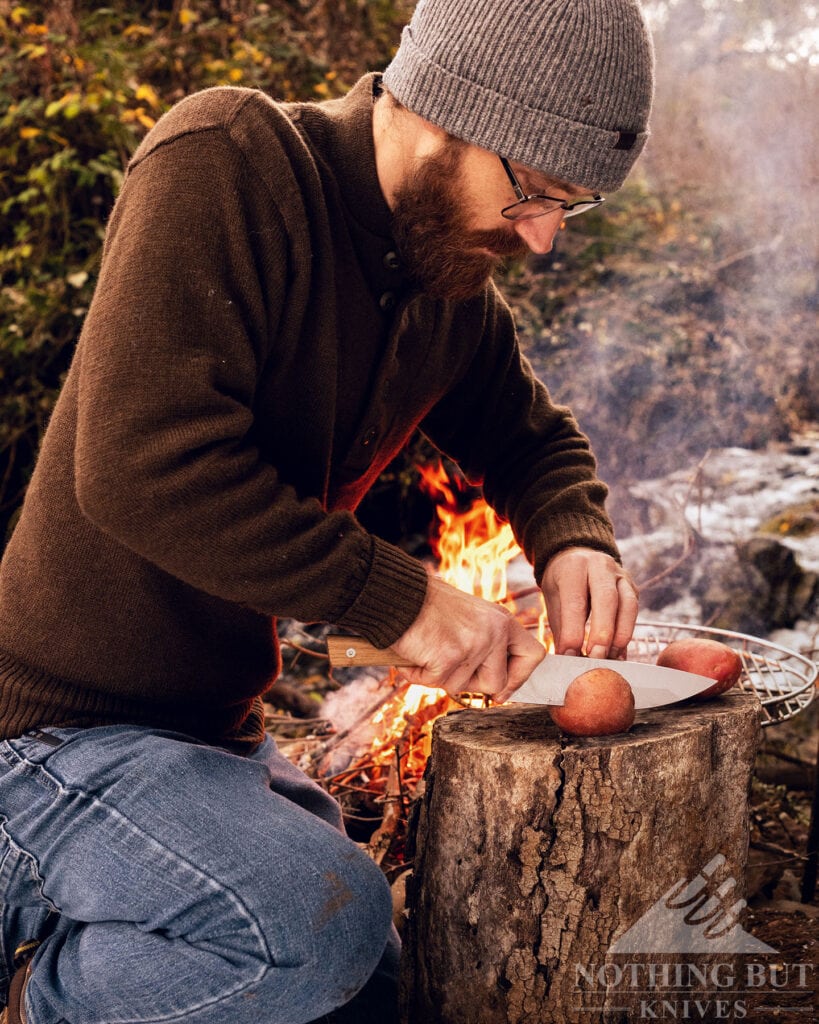
A knife should at least be able to break the skin of an onion easily. Because of this, we mostly pick flat grinds for this list. Things like scandi grinds don’t usually make it on here because even when an edge like that is sharp, it’s hard to cut even slices through larger foods.
A thin edge is a little hard to find in the outdoor knife world, but we weren’t exactly looking for 12-degree Japanese angles. Sometimes a thin edge means a gradual slope from the secondary bevel, and sometimes it means a highly acute microbevel. We just like the knife to cut food cleanly. And if it can’t do that, it should be easy to grind it down so that it can be made to cut food cleanly (see durability and versatility above).

When a Andrew degrades a knife because its not “sharp” he confirms both his lack of knowledge of knives and his lack of ability to sharpen a knife. Why would I listen to a reviewer of knives that does not understand knifes.
If he was telling us the steel in the knife is inferior as it will not hold an edge or that the steel is so hard its difficult to sharpen that would have been beneficial. However his only comment was “the blade isn’t all that sharp” which tells me he still writes mundane descriptions and drinks too much whisky.
Did writing that make you feel better, or would you like to comb through a few more of our blogs for other little details to criticize? I’m just wondering how large the next shot I pour should be.
As long as we’re nitpicking little details – why would I trust the knife knowledge of a commenter when he writes “knifes”?
Thanks Andrew for the well written review!
Thanks for reading, Scott, my only friend in this whole comment section.
I agree with Bill, “blade isn’t all that sharp” is not a useful description – sharpen it. Since that blade is made from 1.4116 steel, I assume you meant that it won’t stay sharp.
It’s more about the fit and finish than the edge. And I do, in fact, mention that it’s easy to strop and sharpen some forty-odd words down from the phrase you two are so caught up on.
Consider an inexpensive Japanese style knife for camp cooking. A smallish 165mm Santoku will work for everything.
Something like this will completely outclass all of the items mentioned above. It won’t be as tough, but it will be lighter than most, for you weight weenies and will cut like a laser.
https://knivesandstones.us/collections/santoku-all-purpose/products/masutani-vg10-damascus-small-santoku-135mm-western-handle-with-free-premium-knife-guard
I guess my wife leaving the Tojiro DP in the sink every day is as good a test as any for the possible rigors of camping, but I’d still rather have the Off Grid Grizzly around the campfire, and I wouldn’t want either of those knives on an extended backpacking trip.
You’re not wrong, though. We’ll put some links to our kitchen knife articles in here.
Hi Andrew, when you pour yourself a shot, pour me a double will ya. Enjoyed the article. I’ve been looking for a good camp knife for a while now. Tried a Nordsmith Canteen, but if never really connected with me. I was hoping it would become one of those holy grail one knife to rule them all type thing, but I found it didn’t really excel at anything. Thought I would look into a more dedicated camp cook knife, and that CJRB Silax looks like a good option. I hadn’t heard of it before and might check it out. Thanks for all the suggestions.
The CJRB is definitely a good way to go if you’re looking for really clean cutting performance with food.
The thing about the Nordsmith Canteen, and knives like it, is that it was designed for a very broad range of outdoor tasks. The tall blade and handle contouring make it easier to grip for food prep, but the primary grind is too low and wide to really excel the way some people seem to expect when they read the words “excellent food preparation tool”. The Canteen is a great knife and it can cut food, but it can also cut a branch in half and carve out feather sticks. If you want a knife for doing only one of those things, you’ll be happier getting something a little more specialized.
That Grizzly V2 was worth the wait. I have the V1 and have waited for the V2 for what felt like an eternity. I use my V1 everywhere I have access to wood to cut on. Camp, kitchen, pool or, processing, I can use the V1 or V2 for the ease of cutting and the comfortable handle and geometry.
I definitely agree. The V1 was good, but the V2 really feels like the same thing with everything done a bit better. It’s pretty quickly become our gold standard for camping chef knives.
Not a single one from the USA but you are looking for the best? The best at supporting other economies? The best for keeping manufacturing down in the USA? What is your criteria for best?
I feel like we covered our criteria pretty well under the section called “What Makes a Good Outdoor Chef’s Knife”, but we could probably shorten the whole thing to “cut good, no chip, has sheath”.
I’ll admit US manufacturing is underrepresented here, and you are of course free to make a suggestion to rectify that, but in the meantime you sound like you might be interested in looking over our Guide to American Made Knives.
I think the best camp chef knife is the Ron Hood designed HCK1 that was sold by CRKT and made by Tops but it is now discontinued. I think the second best would probably be the FMS XL that is also made by Tops, although it does have a longer, slightly different design. I would put both of these ^ knives over any on that list.
This page popped up when i was looking for something else and i took the time to see what knives you had found and what selection criteria you had landed on. So many people want to make one knife work for survival/bushcraft/camp kitchen, I can’t make that work. Thick blade steel of a heavy survival knife is pretty ordinary for slicing carrot or tomato or cheese any range of foods. For food prep my preference is a thinner blade stock with full flat grind, or a high sabre grind with just enough flat area high up near the spine to clamp it into my sharpener. As you note “knuckle clearance” is important for efficient food prep, I wasn’t familiar with that expression but i knew what you meant the moment i saw it on the page. You’ve introduced me to the Ontario Camp Plus folding bread knife as an addition to my camp kitchen. Thanks for the article.
Honestly we could have left this list at the OKC Plus folding knives and the Off Grid Sierra, but that would take all the fun out of it.
Glad you found something useful in here. Happy cookin’.
Hey thank you for taking the time to write this article! I hadn’t considered getting a separate knife for food prep but after reading, it really makes sense!
It’s funny, a lot of the people I’ve talked to who don’t get a separate knife for it. They either take their regular kitchen knife in a sheath or roll or they just use their hunting knife.
Glad we could be of some help.